











Regarded as a model, guide and protector, Saint Joseph is patron of the Institute of the Brothers of the Christian Schools. To honor the 150th anniversary of the declaration of Saint Joseph as Patron of the Universal Church, Pope Francis declared 2021 a special Year of Saint Joseph. With this, the Superior General and General Council announced 2021 as the Lasallian Year of Saint Joseph.
This issue of De La Salle Today celebrates the Year of Saint Joseph. Our first story explores Pope Francis’ Apostolic Letter on Saint Joseph, Patris Corde (With a Father’s Heart), and the writings of Saint John Baptist de La Salle related to Saint Joseph. We also look at the original seal of the Institute, which features Saint Joseph and the child Jesus.
In his meditation for Saint Joseph, De La Salle urged the Brothers to embody Joseph’s qualities of being just, showing fidelity to obedience and caring for Jesus. As this call extends to today’s Brothers and Lasallian Partners, you’ll read reflections on what the meditation means in ministry today. In Patris Corde, Pope Francis described Joseph as a “man who goes unnoticed, a daily, discreet and hidden presence” and reminded us of the impact those “in the shadows” can have. We invited nominations to find those “silent ones,” and we highlight them here and on www.Lasallian.info. This issue also features a powerful reflection from Brother Ghebreyesus Habte, FSC, Lwanga District Visitor, on his connection to Saint Joseph through his years at Saint Joseph School in Keren, Eritrea.
As Saint Joseph offers an example of a model and guide, flip to the center of this issue for Lasallian Essentials, which focuses on Circular 475, From Hope to Commitment: Understanding Lasallian Vocations, to explore ways you can serve as a model and guide. Finally, as we mark the 330th anniversary of the Heroic Vow, Brother Gerard Rummery, FSC, explores the events that led up to the vow and the idea of it being considered the Founding Vow.
We hope this issue provides you with new insights and inspiration. Visit www.Lasallian.info/Year-ofSaint-Joseph to learn more about the year.
Christian Brothers Conference
415 Michigan Avenue NE, Suite 300, Washington, DC 20017 202-529-0047 | communications@lasallian.info | www.lasallian.info
General Councilor, RELAN
Brother Timothy Coldwell, FSC
Executive Director, Of fice for Lasallian Education
Mark John Freund
Editor
Elizabeth Moors Jodice
Assistant Editor
Ashley Fletcher
Story Development
Bob Carrejo
Philip De Rita
Denis de Villers
David Genders
Editorial Support
Brother Timothy Coldwell, FSC
James Lindsay
Chris Swain
Translation
Denis de Villers
Contributing Writers
Brother John Crawford, FSC, Ph.D.
Ashley Fletcher
Brother Ghebreyesus Habte, FSC
Elizabeth Moors Jodice
Brother Gerard Rummery, FSC
Chris Swain
Brother George Van Grieken, FSC
Photography and Artwork
Brother Moses Abunya, FSC
Joe Alexander-Short/District of San Francisco New Orleans
Brother Richard Buccina, FSC
Colegio De La Salle
District of San Francisco New Orleans
Institute of the Brothers of the Christian Schools
Communications Service
Thank you to the ministries and educators who provided pictures for the stories featuring educators.
Student Artists
Adiyan, La Salle Academy, New York, NY
Elijah, La Salle Academy, New York, NY
Li, La Salle Academy, New York, NY
Liam, La Salle College High School, Wyndmoor, PA
Tre’, Christian Brothers Academy, Syracuse, NY
Design Consultant
Matthew Chverchko
Please email comments and suggestions to communications@lasallian.info. The editor of De La Salle Today reserves the right to edit and make final decisions regarding the content published in the magazine.
Elizabeth Moors Jodice, Editor De La Salle Today is published by Christian Brothers Conference for the Lasallian family in the Lasallian Region of North America (RELAN).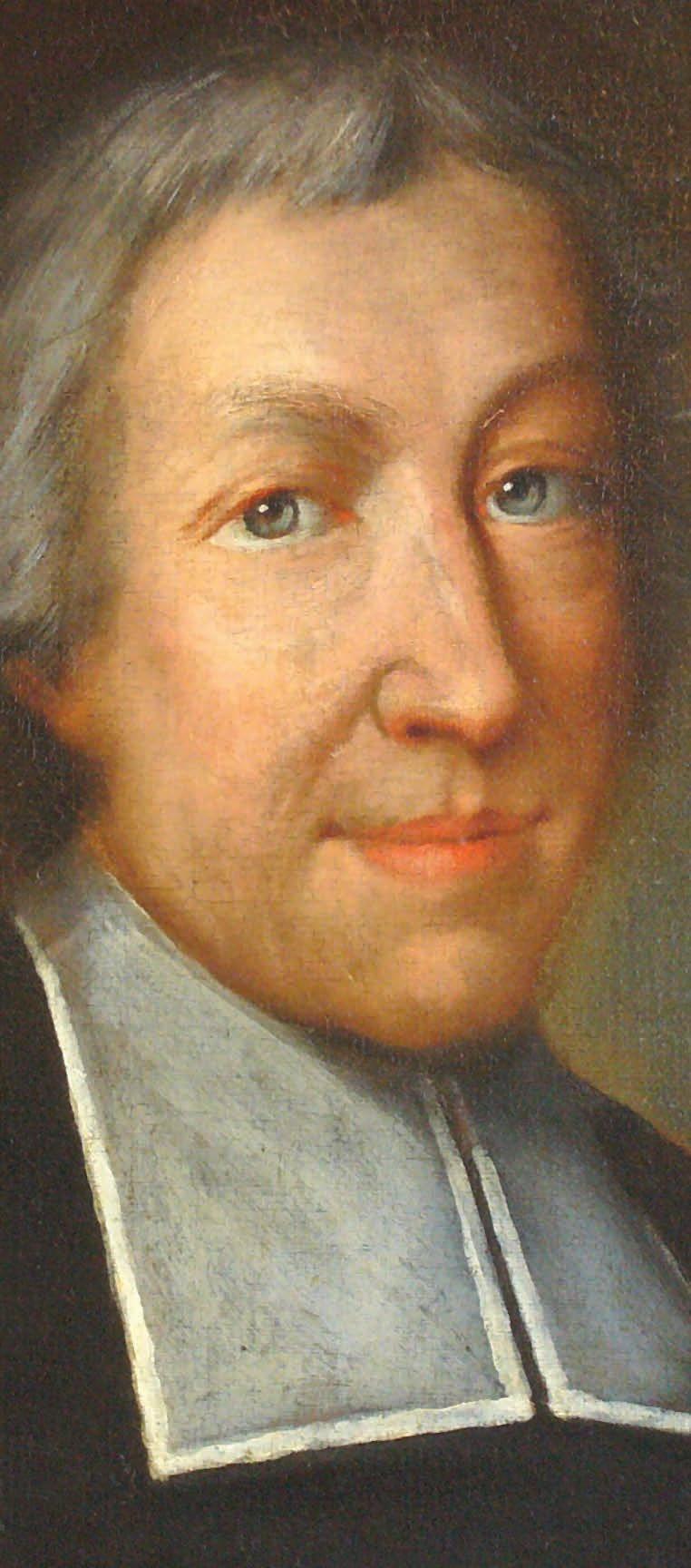
Three key events leading up to the 46th General Chapter have taken on new forms as planning adapts to life in a pandemic. The events kicked off with the first meeting of the 4th International Symposium of Young Lasallians (ISYL) on June 30, 2021. “United in Community and Mission: Being Protagonists of the Future!” is the theme of the symposium, which is being held in two phases. The first phase took place virtually in October, and the next phase will take place in person in 2022. Following ISYL, the 2nd International Young Brothers Assembly (IYBA), themed “Passionate Witnesses of Fraternity,” met virtually in November. This was the second of four IYBA gatherings that will take place before the General Chapter, with the others to be held in January and March. Similar to ISYL and IYBA, the first phase of the 3rd International Assembly of the Lasallian Educational Mission (AIMEL) is taking place virtually between November and April 2022, and the second phase will be in person October 28 – November 4, 2022, in Rome. “Identity. Vitality. Transformation. Together, we make it possible!” is the theme for AIMEL. The General Chapter is scheduled to be an in-person gathering in Rome, May 1-22, 2022, with the theme “Building New Paths to Transform Lives.” Typically held every seven years, the 2022 General Chapter was postponed for one year due to COVID-19. The Chapter evaluates the life of the Institute, provides for its continuing adaptation and renewal, and sets out the main guidelines for future action. The next issue of De La Salle Today will include a deeper look ahead to the General Chapter.
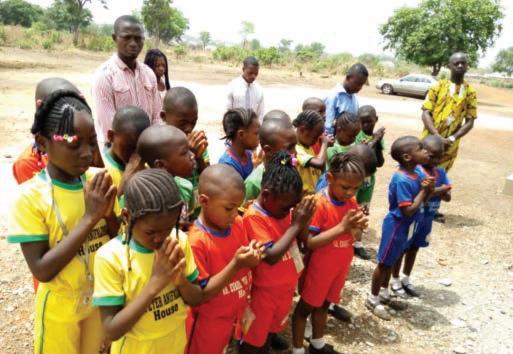
La Salle Primary School in Naka, Nigeria, and Resurrection College Prep High School in Chicago, Illinois, joined the twinning program with the start of the 2021-2022 school year. La Salle Primary opened in September 2019 with one first grade class and now educates students in grades first through third. Resurrection College Prep, an all-girls school founded by the Sisters of the Resurrection in 1922, joined the Lasallian family in August 2020. With these additions, 15 ministries in Lwanga are twinned with 64 secondary and middle schools in the Lasallian Region of North America (RELAN). The twinning program began in 1995 in response to a call from the Institute of the Brothers of the Christian Schools to financially support Districts in need. Twinning provides not only financial resources to Lwanga educational ministries, but also engages students in building relationships with Lasallians from different cultures. Visit www.Lasallian.info/Twinning to learn more.
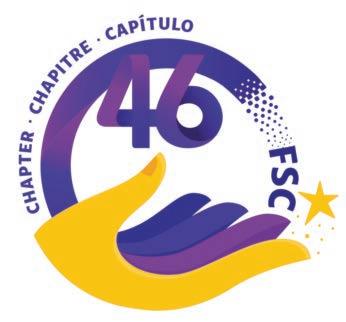
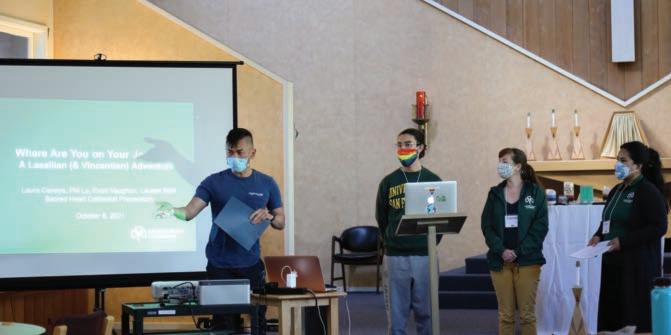
The first in-person formation program gatherings in more than a year for the Of fice for Lasallian Education (OLE) at Christian Brothers Conference took place in October with two gatherings of the Brother John Johnston Institute of Contemporary Lasallian Practice. These gatherings marked the final meetings of the third cohort. The Huether Lasallian Conference, which was held virtually in 2020, brought together Lasallians in Baltimore, Maryland, from November 18-20. Prior to these in-person gatherings, OLE hosted virtual sessions of formation programs to continue programming and keep participants connected during the pandemic. Over the summer, 120 Lasallians gathered virtually for the Johnston Institute, the Buttimer Institute of Lasallian Studies and the Lasallian Social Justice Institute (LSJI). Johnston participants gathered as a Regional group July 12-15, 2021. The LSJI OK-NI-SOO-KA-WA Blackfeet Virtual Immersion program took place July 20-22 in partnership with De La Salle Blackfeet School in Browning, Montana. Next summer, participants will travel to Browning for an in-person program. Participants of Buttimer gathered virtually throughout June, July and August for informal programming, which included a roundtable talk with Brother Superior General Robert Schieler, FSC. These formation experiences allowed Lasallians to come together for prayer, community building, learning and sharing with one another. To learn more about RELAN formation programs, visit www.Lasallian.info/Programs.
A new fundraising partnership will help support projects of Lasallian Women of Hope (LWH) around the world. FairTrade Caravans has chosen LWH as one of three projects to receive 25% of proceeds from FairTrade Caravans sales of items such as jewelry, coffee, chocolate and more. Established in 2016, LWH provides grants for grassroots projects that deliver creative, effective and durable solutions to educational inequities for girls and women. Visit www.Lasallian. info/Lasallian-Women-of-Hope to learn more and shop online.

Lasallian Youth gathered for the first time at the Regional level in over 20 years on July 15, 2021. More than 125 young people attended the virtual Lasallian Youth Assembly, themed “Mapping our Lasallian Future.” The gathering, organized by the Districts, provided a formation experience rooted in Gospel and Lasallian tradition, while offering an opportunity to reinvigorate Lasallian Youth as we emerge from the COVID-10 pandemic.
Lasallian Volunteers (LV) started its 2021-2022 service year by looking to the future. The program is undergoing an external review process managed by Plante Moran to identity and articulate the next adaptive move(s) that will ensure the program’s stability and sustainability. The goal is that this process will ensure a shared understanding of the roles each person and group plays in LVs as they prepare for the 2022-2023 service year. This year’s LV cohort includes 16 volunteers, split evenly between new and returning LVs. The volunteers participated in this year’s LVs Run virtually on November 13 by walking and/or running a lap around a landmark in their local area for each donation received. Donations will be accepted through December 31. Visit www.LasallianVolunteers.org to donate.
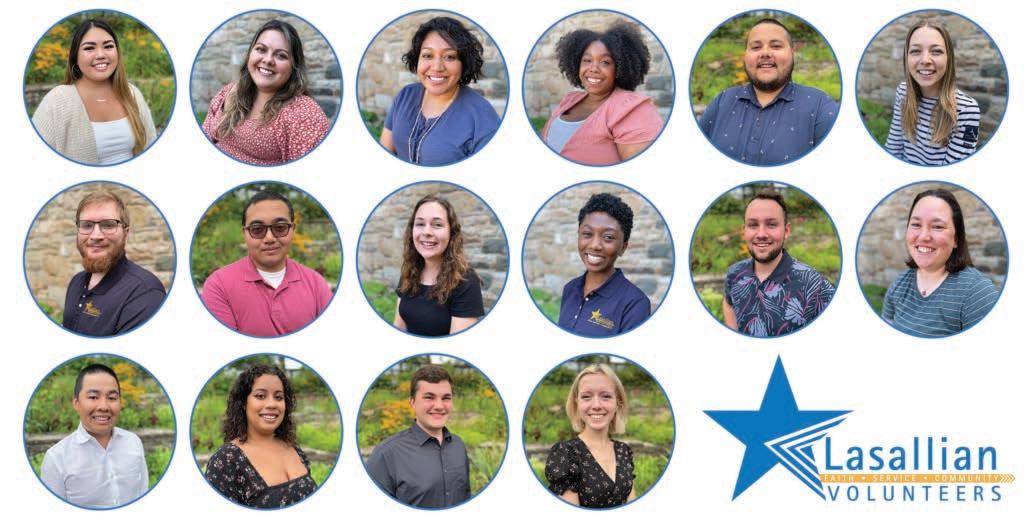
Colegio De La Salle in Bayamón, Puerto Rico, has joined the District of Eastern North America (DENA). Cuban Brother exiles founded Colegio De La Salle in 1961. The school remained part of the Antilles District until 2008, when the Antilles District merged with South Mexico and formed the District of Antilles-South Mexico (DAMS). The school ceremonially transferred its covenant relationship from DAMS to DENA during a celebration at Colegio De La Salle in August 2021.
Colegio De La Salle is DENA’s first K-12 school.
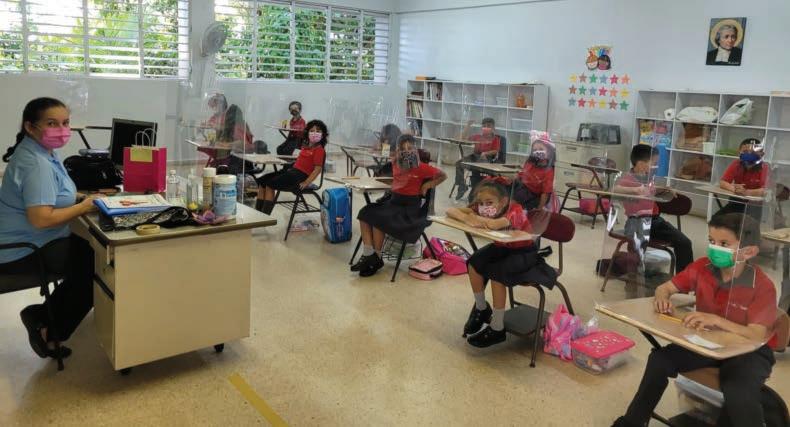
Lasallians recognized with Letters of Af filiation (AFSC) have been formally honored by the Institute of the Brothers of the Christian Schools for having served the Lasallian mission in an extraordinary way. Lasallians who receive Letters of Benefaction (BFSC) have been formally honored by the Institute for important services rendered to the Lasallian mission. Read more about these individuals and their contributions to the Lasallian mission at www.Lasallian.info.
District of Eastern North America
Monsignor Ron Bill, AFSC, a 1949 graduate of Christian Brothers Academy in Syracuse, New York, received Letters of Af filiation on June 19, 2021, in a ceremony at the school. Msgr. Bill has served on the board of trustees since 2001 and currently serves as an honorary member.
Midwest District
Bishop John M. Quinn, AFSC, the bishop of the Diocese of WinonaRochester, received Letters of Af filiation during a ceremony held August 25, 2021, at the Brothers’ residence at Saint Mary’s University of Minnesota in Winona. Bishop Quinn has taught in the theology department and served on the board of trustees since 2008.
“To Dream is Our Way Forward” is the Lasallian theme for the 2021-2022 liturgical year. Lasallian Reflection 7 accompanies the theme and invites Lasallians to look toward the horizon of dif ficult but possible projects, encouraging them to believe in the dreams that can come true when as a community they bring their passion for humanity to all their encounters. This year’s theme is the latest in a series of annual themes developed by the Brother Superior and General Council.
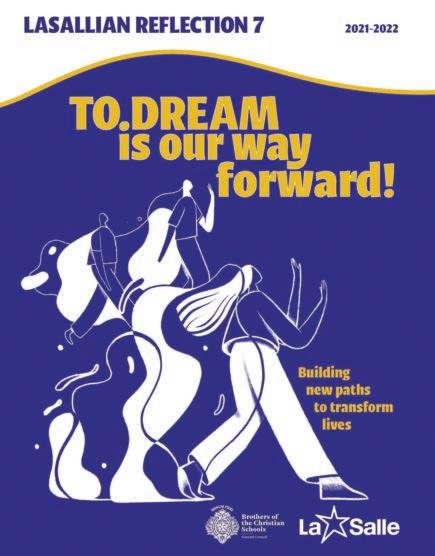
Following the General Chapter in 2014, seven themes were released to help Lasallians gain insights and develop integrated responses to extend and deepen the relevance of the Lasallian mission. “To Dream is Our Way Forward” was developed following the postponement of the 46th General Chapter. Resources are available at www.Lasallian. info/Dream, including Lasallian Reflection 7, the theme logo and poster in English, French and Spanish featuring reflection questions appropriate for educators and students (pictured on opposite page).
Jamal Adams, Principal, La Salle College Preparatory, Pasadena, CA, effective July 1, 2021
Colleen Brewer, Principal, Resurrection College Prep High School, Chicago, IL, effective July 2021
Thomas Coughlan, President, Saint Michael’s High School, Santa Fe, NM, effective July 1, 2021
Brother Jules “Bud” Knight, FSC, Assistant Visitor, District of Eastern North America, effective September 1, 2021
Lars Lund, Interim President, Justin-Siena High School, Napa, CA, effective July 1, 2021
Judith Mbuya, Development Assistant, Christian Brothers Conference, Washington, DC, effective October 18, 2021
Jessica Murray, Principal, Cristo Rey De La Salle East Bay High School, Oakland, CA, effective July 19, 2021
Alanna O’Brien, Principal, La Salle Catholic College Preparatory, Milwaukie, OR, effective July 1, 2021
Tim O’Shaughnessy, Interim President, La Salle University, Philadelphia, PA, June 1, 2021
Erin Reid, Principal, De La Salle North Catholic High School, Portland, OR, effective July 1, 2021
What concrete steps can you take to spread hope?

What can you do to deepen and maintain relationships within your Lasallian family?
How can you be an open ear and heart for those in need?




How can you fight against the status quo and enact change?

In what ways can you help advocate for quality education for the most vulnerable?
How can you pave new roads and transform lives during the pandemic and beyond?
What motivates you to see a brighter future, and how can you encourage people to see the same?


What signs do you see of God’s support in your life?
How can you be a voice for the vulnerable, not only in your community but around the world?
In what ways can you break barriers and advocate for justice?


n In his Apostolic Letter Patris Corde (With a Father’s Heart), Pope Francis invited the Universal Church to celebrate and learn from the example of Saint Joseph during a special year beginning in December 2020. Pope Francis noted that among the many attributes of Saint Joseph are “the numerous religious Institutes, Confraternities and ecclesial groups inspired by his spirituality.”1
The Brothers of the Christian Schools belong to this legacy of religious institutes, as Saint John Baptist de La Salle entrusted the Institute to the patronage of Saint Joseph. Devotion to Joseph was foundational in De La Salle’s own personal piety, and he shared his enthusiasm for Joseph’s ef ficacy with his community of Brothers.
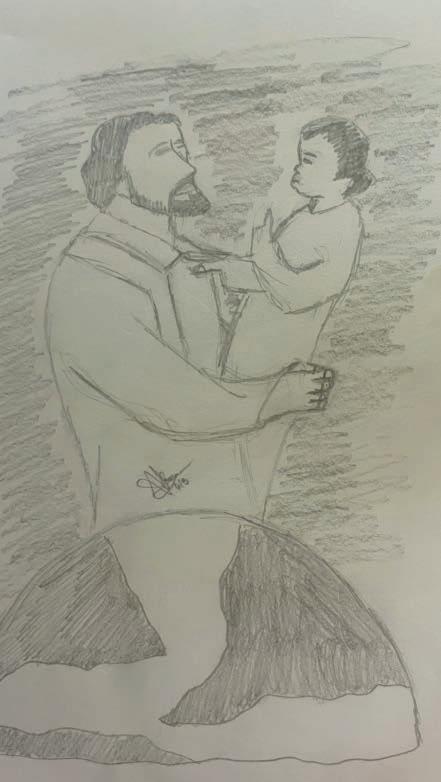
In Patris Corde, Pope Francis emphasizes seven aspects of the “fatherhood” of Saint Joseph as virtues to be engaged by contemporary Christians. His hopes for this reflection are clear: “Each of us can discover in Joseph—the man who goes unnoticed, a daily, discreet and hidden presence—an intercessor, a support and a guide in times of trouble. Saint Joseph reminds us that those who appear hidden or in the shadows can play an incomparable role in the history
of salvation. A word of recognition and of gratitude is due to them all.”2
Joseph becomes the subject of discovery through his very simplicity and dependability. Joseph presents a model for ministry and an intercessor for assistance in our work. His way is worthy of imitation, even as we acknowledge that the historical Joseph is a person about whom we know very little.
Pope Francis interprets the meaning of Joseph’s fatherly devotion to Jesus and spousal dedication to Mary, and, by extension, his value for us, through seven interlocking phrases: “beloved father,” “tender and loving father,” “obedient father,” “accepting father,” “creatively courageous father,” “working father” and “father in the shadows.”
Pope Francis invites us to go to the “school of Joseph,”3 because Joseph’s fatherhood allowed him to teach Jesus both the practicalities of daily living as a carpenter and the requirements of faithful Jewish practice. Significantly, for Lasallians, Pope Francis highlights the educator in Joseph, who passed along both practical skills and personal faith. In the cultural context of his times, Joseph was the tender and devoted head of the family who protected his wife and son, as the Gospels, especially Matthew, so vividly attest.
The Joseph in Matthew is a man whose readiness to act upon dreams allows him to accept Mary (with her “mysterious pregnancy”4) as his spouse, although he might have denounced her, and to embrace her child as his own, to name him Jesus (literally “God saves”), to protect his son from the malicious powers of Herod, and to bring him up securely and quietly in Nazareth. In those actions, Joseph shows that he is a person of “obedience,” a virtue grounded in its core meaning indicating someone who is willing to listen and to act.
Joseph could have chosen to walk away from all of this, but his openness to hearing God speak through the events of his life, baf fling as they may have been, speaks to the quality of “Christian realism,” which Pope Francis describes as “Joseph’s attitude” which “encourages us to accept and welcome others as they are, without exception, and to show special concern for the weak.”5
Lasallians can see in Joseph an exemplar who can dream, see and hear beyond the surface and act. De La Salle wrote, “Recognize Jesus beneath the poor rags of the children whom you have to instruct. Adore him in them.”6 This “Christian realism” echoes the scholarly insight of Brother Michel Sauvage, who described in De La Salle’s life an operative “mystical realism.” Sauvage explains that this mystical
realism permeates De La Salle’s spiritual teachings, founded, like the spirituality of Saint Joseph, in attentive listening and the definitive determination to act upon the reality we perceive in our world, starting with the concrete situation, expanding to contemplate the mystery behind it all, committing to transform the present reality in positive ways, and being open to the ever-present reality of God being discovered in our daily lives.7
The Lasallian practice of mystical realism makes it possible to view those entrusted to our care as a means to meet God in our daily efforts. Clearly, our “work” in education makes great demands upon us, but this endeavor also fulfills us as God’s plan for our mutual salvation. Joseph has been honored with the title “the Worker,” which appeals to all of us as “cooperating with God himself, [sic] and… become creators of the world around us.”8 Educators have a special mission to help create a better world, and Joseph intercedes for us in this effort, since he learned to use the circumstances of his daily life as the way in which God allowed him to discover his place in God’s plan.
The last major point of Pope Francis’ letter invites us to understand Joseph as a “father in the shadows.” This simile rests on the remarkable fact that Joseph in the New Testament is a man
who acts wisely and well but is not recorded as speaking even one single word! His silence, obscurity and hiddenness are among the attributes that Scripture emphasizes about Joseph. Lasallians are aware that De La Salle recommended (and as Brother Agathon later expanded upon) as one of the “Twelve Virtues of a Good Teacher” the importance of “silence.” Joseph’s “shadow” is emblematic of that virtuous silence. De La Salle understood Joseph’s power. “If you want the instructions you give those whom you have
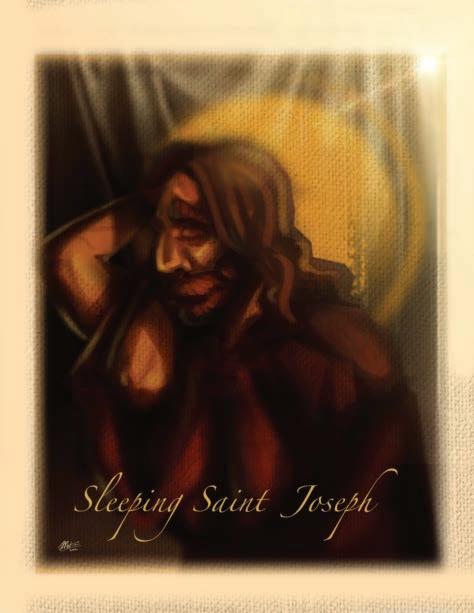
to instruct to be effective in drawing them to the practice of good, you must practice these truths yourselves…”9 Joseph did not have to say much to be an eloquent witness to God. He did so by way of his daily activities in a hidden, quiet life.
John Baptist de La Salle wrote several reflections about the importance of Saint Joseph in his lifetime. The clearest distillation of his thinking may be found in the Meditation 110 for the Feast of Saint Joseph, which will be handled elsewhere in this publication (see page 21). De La Salle’s work complements
Pope Francis’ letter very well as someone “made responsible by God for the care and external guidance of Jesus Christ.”10
Elsewhere, De La Salle provides some succinct and insightful observations about Joseph in his extensive catechetical work, The Duties of a Christian to God. De La Salle’s catechism mirrors the style of religious education after the Council of Trent, which relied upon students to memorize questions and answers to “learn” their religion. Stylistically, the document is clear, orderly and succinct, intended to make it easier for the young students to remember the “right answers.” Yet, the material about Saint Joseph gets quickly to the heart of what is important about him. Take these few examples as illustrative of what De La Salle emphasized about the meaning of Saint Joseph for the students to remember:
Q: Was Saint Joseph well known in the world?
A: No, because no one had any special esteem or
consideration for him, knowing him merely as a poor carpenter.
Q: Why was Saint Joseph totally unknown in the world?

A: He led a hidden life and visited no one.11
For De La Salle, the “hidden” and “unknown” virtues of Saint Joseph identified his agency as a servant of God rather than a seeker of fame.
Q: How virtuous was Saint Joseph?
A: He was virtuous to an eminent degree, which is why the Gospel says of him, in a word, he was a just man.
Q: What were Saint Joseph’s special virtues?
A: There are five in particular: 1) chastity… 2) faith… 3) exact obedience… 4) humility…5) love of solitude and silence…12
Q: What virtues of Saint Joseph should we try to imitate?
A: We should imitate his purity, his prompt obedience, and his humble, poor, hidden and hardworking life.13
Artwork by Tre’, student at Christian Brothers Academy, Syracuse, NYPerhaps this answer also typifies what De La Salle hoped to see as the qualities of his Brothers, and by extension, in all who educate.
Pope Francis’ letter places great emphasis on the “fatherly” activity of Saint Joseph. Ordinarily, Lasallians emphasize the “brotherly-sisterly” relationship of teachers and students. Yet, the experiences and writings of De La Salle clearly indicate that he understood the connection between sibling mentoring and parental roles. For example, in the First Meditation for the Time of Retreat, De La Salle observes that while it is primarily the responsibility of parents to bring their children up in a Christian spirit, they are often ill-equipped to do so. As a result, they have been blessed
by God’s providence to turn to gifted teachers who “substitute for fathers and mothers persons who have enough knowledge and zeal to bring children to the knowledge of God…”14 While the Lasallian method emphasizes the sibling role, it is not without some parenting connections, for which a mentor like Joseph represents an ideal. Ultimately, Pope Francis commends Saint Joseph to our attention today as an exemplar of the Christian vocation. “Joseph found happiness not in mere self-sacrifice, but in self-gift … Every true vocation is born in the gift of oneself, which is the fruit
of mature sacrifice … In a way, we are all like Joseph: a shadow of the heavenly Father …”15
John Baptist de La Salle would fully agree. As Pope Francis invites us to honor and learn from the example of Saint Joseph who lived “with a Father’s heart,” De La Salle reminds us that our sincerest hope is to “touch hearts” in loving, humble, often hidden service to one another. We can learn much in the “school of Saint Joseph.” n
Brother John Crawford, FSC, Ph.D., is an associate professor of religion and theology at La Salle University in Philadelphia, Pennsylvania.
1. Pope Francis. Patris Corde: On the 150th Anniversary of the Proclamation of Saint Joseph as Patron of the Universal Church. Vatican City, December 8, 2020, Section 1.
2. Patris Corde. Introduction.
3. Patris Corde. Section 3.
4. Patris Corde. Section 3.
5. Patris Corde. Section 4.
6. John Baptist de La Salle. Meditation
96.3. “For the Feast of the Adoration of the Kings.” Meditations by John Baptist de La Salle. Landover, MD: Christian Brothers Conference, 1994, p. 179.
7. Michel Sauvage, FSC, Luke Salm, FSC, Translator. “The Gospel Journey of John Baptist de La Salle” in Robert Berger, FSC, editor. Spirituality in the Time of John Baptist de La Salle. Landover, MD: Lasallian Publications, 1999, p. 224.
8. Patris Corde. Section 6.
9. John Baptist de La Salle. Meditations for the Time of Retreat, 194.3. Meditations, p. 436.
10. John Baptist de La Salle. Meditation
110.1 For the Day of the Feast of St. Joseph. Meditations, p. 200.
11. John Baptist de La Salle. The Duties of a Christian to God. Landover, MD: Lasallian Publications, 2002, p. 487.
12. Duties, p. 488.
13. Duties, p. 489.
14. John Baptist de La Salle. First Meditation for the Time of Retreat, 193.2. Meditations, p. 433.
15. Patris Corde, Section 7.
De La Salle reminds us that our sincerest hope is to “touch hearts” in loving, humble, often hidden service to one another.
n Dans sa lettre apostolique Patris Corde (Avec un cœur de Père),le pape François a invité l’Église universelle à célébrer et à apprendre de l’exemple de saint Joseph en cette année toute spéciale qui a débuté en décembre 2020. Le pape François a noté que, parmi les nombreux attributs de saint Joseph, se retrouvent « les nombreux instituts religieux, confréries et groupes ecclésiaux inspirés par sa spiritualité ».1
Les Frères des Écoles Chrétiennes appartiennent à cet héritage d’instituts religieux, car saint Jean-Baptiste de La Salle a confié l’Institut au patronage de saint Joseph. La dévotion à Joseph fut fondamentale dans la piété personnelle de De La Salle, et il partageait, avec sa communauté de Frères, son enthousiasme pour l’ef ficacité de Joseph.
Dans Patris Corde, le pape François met l’accent sur sept aspects de la « paternité » de Joseph en tant que vertus à appliquer par les chrétiens contemporains. Ses espoirs sont clairs : « Chacun de nous peut découvrir en Joseph l’homme qui passe inaperçu, une présence quotidienne, discrète et cachée ; un intercesseur, un soutien et un guide dans les moments dif ficiles. Saint Joseph nous rappelle que ceux qui apparaissent cachés ou
dans l’ombre peuvent jouer un rôle incomparable dans l’histoire du salut. Un mot de reconnaissance et de gratitude leur est dû à tous. »2
Joseph devient donc un sujet de découverte par la simplicité et la fibilité qui l’animent. Joseph représente un modèle pour notre ministère et un intercesseur qui nous soutient dans notre travail. Sa vie est digne d’être imitée, même si nous reconnaissons que le Joseph historique est une personne dont nous savons très peu de choses.
Le pape François interprète le sens de la bienveillance paternelle de Joseph à l’endroit de Jésus et de son dévouement conjugal à Marie, et, par extension, sa valeur de modèle pour nous, à travers sept phrases interreliées : « père aimé », « père dans la tendresse», « père dans l’obéissance », « père dans l’accueil », « père au courage créatif », « père travailleur » et « père dans l’ombre ».
Le pape François nous invite à aller à « l’école de Joseph »,
parce que la paternité de Joseph lui a permis d’enseigner à Jésus à la fois les aspects pratiques de la vie quotidienne en tant que charpentier et les exigences de la pratique juive3 fidèle. De manière significative, pour les Lasalliens, le pape François met en évidence l’éducateur en Joseph, qui a transmis à la fois des compétences pratiques et une foi personnelle. Dans le contexte culturel de son époque, Joseph était le chef tendre et dévoué de la famille qui protégeait sa femme et son fils, comme l’attestent si bien les Évangiles, et en particulier Matthieu.
Le Joseph dans Matthieu est un homme dont la volonté d’agir sur les rêves lui permet d’accepter Marie (avec sa « grossesse mystérieuse ») comme son épouse, bien qu’il ait pu la dénoncer, et d’embrasser son enfant comme le sien, de le nommer Jésus (littéralement « Dieu sauve »), pour protéger son fils des pouvoirs malveillants d’Hérode, et de l’élever en toute sécurité et quiétude à Nazareth.4 Dans ces actions, Joseph montre qu’il est une personne d’« obéissance », une vertu fondée sur son sens fondamental indiquant quelqu’un qui est prêt à écouter et à agir.
Joseph aurait pu choisir de s’éloigner de tout cela, mais son ouverture à entendre Dieu parler
« La dévotion à Joseph fut fondamentale dans la piété personnelle de De La Salle. »
à travers les événements de sa vie, aussi déconcertants qu’ils aient pu être, témoigne de la qualité du « réalisme chrétien », que le pape François décrit comme « l’attitude de Joseph » qui « nous encourage à accepter et à accueillir les autres tels qu’ils sont, sans exception, et de faire preuve d’une préoccupation particulière pour les faibles. »5
Les Lasalliens peuvent voir en Joseph un exemple qui permet de rêver, de voir et d’entendre au-delà de la surface et d’agir. De La Salle a écrit: « Reconnaissez Jésus sous les pauvres haillons des enfants que vous devez instruire. Adorez-le en eux. » Ce « réalisme chrétien » fait écho à la perspicacité savante du frère Michel Sauvage, qui a décrit dans la vie de De La Salle un « réalisme mystique » opérationnel. Sauvage explique que ce réalisme 6 mystique imprègne les enseignements spirituels de De La Salle, fondés, à l’instar de la spiritualité de saint Joseph, dans l’écoute attentive et la détermination d’agir sur la réalité que nous percevons de notre monde, en commençant par la situation concrète, en s’élargissant pour contempler le mystère qui se cache derrière tout cela, en s’engageant à transformer la réalité présente de manière positive, et être ouvert à la réalité toujours présente de Dieu découvert dans notre vie quotidienne.7
La pratique lasallienne du réalisme mystique permet de voir ceux qui nous sont confiés
comme un moyen de rencontrer Dieu dans nos efforts quotidiens. De toute évidence, notre « travail » dans l’éducation nous impose de grandes exigences, mais cet effort nous accomplit aussi en tant que plan de Dieu pour notre salut mutuel. Joseph a été honoré du titre de « Travailleur », qui nous appelle tous à « coopérer avec Dieu lui-même [sic] et... devenir les créateurs du monde qui nous entoure. Les éducateurs ont une mission particulière d’aider à créer un monde meilleur, et Joseph intercède pour nous dans cet effort,8 puisqu’il a appris à utiliser les circonstances de sa vie quotidienne comme la façon dont Dieu lui a permis de découvrir sa place dans le plan de Dieu.
Le dernier point majeur de la lettre du pape François nous invite à comprendre Joseph comme un « père dans l’ombre ». Cette compréhension repose sur le fait remarquable que Joseph dans le Nouveau Testament est un homme qui agit sagement et bien, mais pour lequel on n’attribue aucune parole! Son silence, son obscurité et son caractère discret sont des traits que les Écritures nous laissent sur Joseph.
Les Lasalliens sont conscients que De La Salle a souligné et recommandé (et comme frère
Des élèves lasalliens furent invités à interpréter de façon créative et artistique leur perception de saint Joseph et du jeune Jésus pour le présent numéro de De La Salle Today Vous retrouverez leurs œuvres intégrées à l’ensemble de la revue.
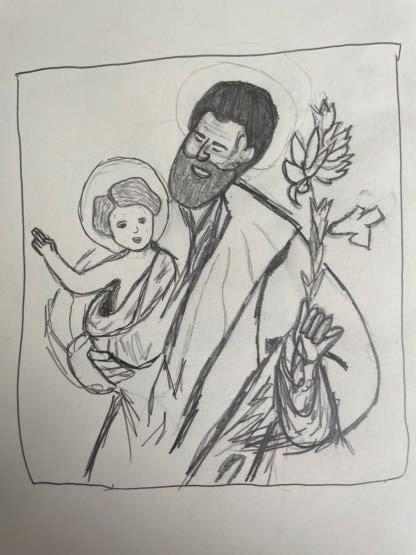
Oeuvre réalisée par Li, élève à La Salle Academy, New York, NY
Artwork by Li, student at La Salle Academy, New York, NY
Agathon l’a développé plus tard) « le silence » comme l’une des « Douze vertus d’un bon maître ». « L’ombre » de Joseph est emblématique de ce silence vertueux. De La Salle comprenait le pouvoir de Joseph. « Si vous voulez que les instructions que vous donnez à ceux que vous avez à instruire soient ef ficaces pour les amener à la pratique du bien, vous devez pratiquer ces vérités vous-mêmes... » Joseph n’avait pas grand-chose à dire pour être un témoin éloquent de Dieu.9 Il l’a fait par le biais de ses activités quotidiennes dans une vie cachée et tranquille.
Joseph
Jean-Baptiste de La Salle a écrit plusieurs réflexions sur l’importance de saint Joseph de son vivant. L’essence de sa pensée se trouve dans la Méditation 110 pour la fête de saint Joseph, qui sera traitée ailleurs dans cette publication (voir page 21). Le travail de De La Salle complète très bien la lettre du pape François en tant que personne « rendue responsable par Dieu des soins et de la direction extérieure de Jésus-Christ ».10
Ailleurs, De La Salle fournit quelques observations succinctes et perspicaces sur Joseph dans son vaste travail catéchétique, Les devoirs d’un chrétien à Dieu. Le catéchisme de De La Salle reflète le style d’éducation religieuse après le Concile de Trente, qui comptait sur les élèves pour mémoriser des questions et des réponses pour « apprendre » leur
religion. Sur le plan stylistique, le document est clair, ordonné et succinct, destiné à permettre aux jeunes élèves de se souvenir plus facilement des « bonnes réponses ». Pourtant, le matériel sur saint Joseph va rapidement au cœur de ce qui est important à son sujet. Prenez ces quelques exemples pour illustrer ce que De La Salle a souligné au sujet de la signification de saint Joseph pour que les élèves se souviennent aisément:
Q: Saint Joseph était-il bien connu dans le monde?
R: Non, parce que personne n’avait d’estime ou de considération particulière pour lui, le connaissant simplement comme un pauvre charpentier.
Q: Pourquoi saint Joseph était-il totalement inconnu dans le monde?
R: Il a mené une vie cachée et n’a rendu visite à personne.11
Pour De La Salle, les vertus « cachées » et « inconnues » de saint Joseph identifiient son libre arbitre comme un serviteur de Dieu plutôt que comme un chercheur de gloire.
Q: À quel point saint Joseph était-il vertueux?
R: Il était vertueux à un degré éminent, c’est pourquoi l’Évangile dit de lui, en un mot, qu’il était un homme juste.
Q: Quelles étaient les vertus spéciales de saint Joseph?
R: Il y en a cinq en particulier:
1) la chasteté... 2) la foi...
3) l’obéissance exacte...
4) l’humilité... 5) l’amour de la solitude et du silence...12
Q: Quelles vertus de saint Joseph devrions-nous essayer d’imiter?
R: Nous devrions imiter sa pureté, son obéissance prompte et sa vie humble, pauvre, cachée et travailleuse.13
Peut-être que cette réponse caractérise aussi ce que De La Salle espérait voir se développer comme les qualités de ses Frères, et par extension, pour tous ceux qui éduquent.
La lettre du pape François met l’accent sur l’activité « paternelle » de saint Joseph. Habituellement, les Lasalliens mettent l’accent sur la relation « fraternelle » des enseignants et des élèves. Pourtant, les expériences et les écrits de De La Salle indiquent clairement qu’il comprenait le lien entre le mentorat des frères et sœurs et les rôles parentaux. Par exemple, dans la première méditation pour le temps de la retraite, De La Salle observe que, bien qu’il soit principalement de la responsabilité des parents d’élever leurs enfants dans un esprit chrétien, ces derniers sont souvent mal équipés pour le faire. En conséquence, ils ont été bénis par la providence de Dieu en se tournant vers des enseignants doués qui « remplacent les pères et les mères par des personnes qui ont suf fisamment de connaissances et de zèle pour amener les enfants à la connaissance de Dieu… »14
Bien que la méthode lasallienne mette l’accent sur le rôle des
frères et sœurs, ce n’est pas sans quelques liens parentaux, pour lesquels un mentor comme Joseph représente un idéal.
En fin de compte, le pape François porte saint Joseph à notre attention aujourd’hui comme un exemple de la vocation chrétienne. « Joseph a trouvé le bonheur non pas dans le simple sacrifice de soi, mais dans le don de soi... Toute vraie vocation naît dans le don de soi-même, qui est le fruit d’un sacrifice mature ... D’une certaine manière, nous sommes tous comme Joseph : l’ombre du Père céleste... »15
Jean-Baptiste de La Salle serait tout à fait d’accord. Alors que le pape François nous invite à honorer et à apprendre de l’exemple de saint Joseph qui a vécu « avec le cœur d’un Père », De La Salle nous rappelle que notre espoir le plus sincère est de « toucher les cœurs » dans un service aimant, humble et souvent caché les
uns aux autres. Nous pouvons apprendre beaucoup à « l’école de saint Joseph ».
Veuillez consulter la page 11 pour les notes complémentaires. n
Frère John Crawford, FSC,Ph.D., est professeur agrégé de religion et de théologie à l’Université La Salle à Philadelphie, en Pennsylvanie.
Le Of fice of Vocation Ministry du district de San Francisco – Nouvelle Orléans, a commandé cette nouvelle icône pour commémorer l’année lasallienne de saint Joseph. Créée par Ryan Carreón Aragón, un artiste philippin, l’icône est inspirée du sceau original de l’Institut des Frères des Écoles Chrétiennes, qui met en vedette saint Joseph et l’enfant Jésus. Voir en page 16 pour plus d’informations.
The Of fice of Vocation Ministry of the District of San Francisco New Orleans commissioned this new icon to commemorate the Lasallian Year of Saint Joseph. Created by Ryan Carreón Aragón, a Filipino artist, the icon is inspired by the original seal of the Institute of the Brothers of the Christian Schools, which features Saint Joseph and the child Jesus. See page 16 for more on the seal.
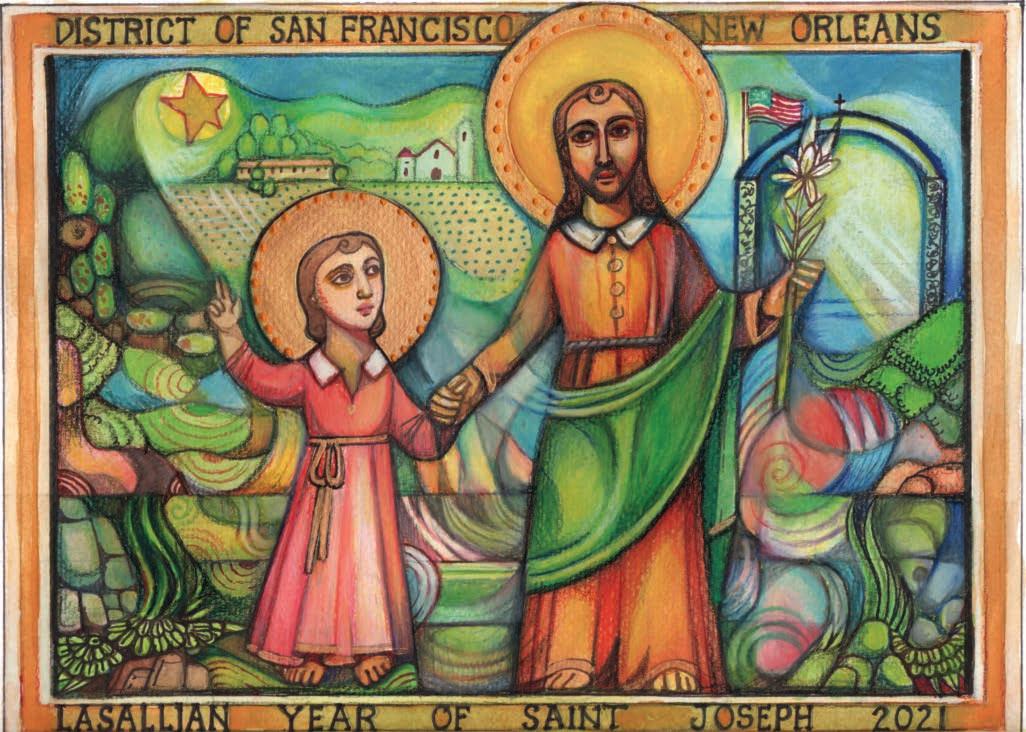
n Saint John Baptist de La Salle’s devotion to Joseph is shown in the original seal of the Institute of the Brothers of the Christian Schools.
A seal has long been the unique marker that represents an individual or organization. Whether stamped onto the hot wax sealing an envelope or printed on of ficial manuscripts, a seal indicates the authority and authenticity of a document. In the 17th century, such seals were in general use throughout Europe. Their design reflected the character and priorities of the owner. The same sentiment is true of the of ficial seal of the Brothers of the Christian Schools.
The earliest recorded seal of the Institute, found on wax impressions from 1709 and 1711 letters written by De La Salle, shows Saint Joseph with a pilgrim’s staff in his left hand, leading the child Jesus. In the upper fragment is the inscription “Live Jesus.”
When the approved Rules and Constitutions were published in Rouen in 1726, a printed rectangular version was used where Saint Joseph is holding a lily in one hand and leading the child Jesus with the other hand. (The lily represents virtue, holiness, innocence and obedience to God.) This same image was used when The Duties of a Christian (1727) and The Explanation of the Method of Mental Prayer (1739) were published.
An oval depiction of this same scene appears on the wax seal of
a 1726 document signed by the Superior General and the Brothers of his governing “Regime.” This oval wax-impression seal was exclusively reserved for use on of ficial documents, but this oval version of the image gradually came to be used by others in the Institute. The initial adoption of the image of Saint Joseph with the child Jesus reflected De La Salle’s great admiration for Saint Joseph, whom he saw as a perfect model for the Brothers and their vocation.
The prominence of Saint Joseph in the early history of the Institute is clear. The 1705 Rule states that “At one o’clock the Brothers will assemble in the oratory to recite the Litany of Saint Joseph, Patron and Protector of the Community, to ask for his spirit and his assistance in the Christian education of children.” (Cahiers lasalliens 25, page 100) The feast of Saint Joseph was one of the special days for a school holiday. And in 1719, about three weeks before his death, De La Salle suddenly recovered enough to be able to say his last Mass with the Brothers at Saint Yon on the feast day of Saint Joseph. The of ficial Bull of Approbation of 1725 also mentions the Institute’s special devotion to the child Jesus and Saint Joseph.
That early seal with Saint Joseph and the child Jesus persisted
until 1751, when the General Chapter adopted the shining star on a blue shield, with the motto “Signum Fidei,” as the of ficial seal of the Institute. This new one would again be for the exclusive use of the Superior General and the governing Regime, but it also gradually came to be used by others.
Today a contemporary version of this 1751 Institute seal is used worldwide. Its latest iteration has been clearly described and defined in the 2021 La Salle Worldwide Identity Manual, which states that it should be used to identify the Institute, particularly the Brothers. n
Brother George Van Grieken, FSC, serves as director of the Lasallian Resource Center (www.LasallianResources.org) and is the Secretary for the Lasallian Research and Resources Service at the Generalate in Rome. Bulletin 148 (January 1957) is the source of the historical information on the seal provided in this article. The Institute of the Brothers of the Christian Schools Communications Service provided the image of the seal.
Lasallian documents. Uncovering Lasallian research. Sparking engagement to build a deeper u nderstanding of mission and community.
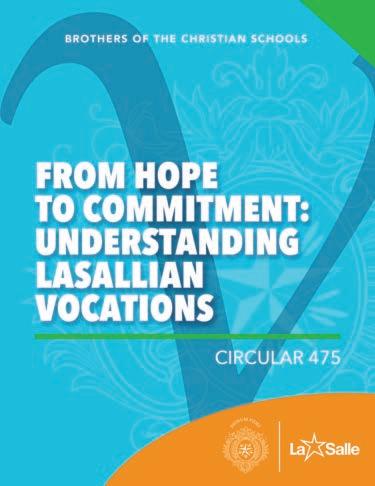
Lasallian Essentials, a recurring feature in De La Salle Today, focuses on bringing Lasallian documents to life. This issue features Circular 475, From Hope to Commitment: Understanding Lasallian Vocations, with the aim of offering insights from the Circular and the opportunity to reflect personally, professionally and spiritually on key takeaways to bring to life as we accompany and serve those entrusted to our care.
There are numerous channels of communicating in the Institute of the Brothers of the Christian Schools and Lasallian family. One of the traditional methods that dates to the time of the founding story is a message, called a Circular, from the Brother Superior (and his Council) on a given topic. They range in topic and style, such as administrative announcements of key events, biographies and theological and practical re fl ections.
The concept of vocation is one rich with meaning for each of us. Some might connect it solely in reference to those discerning religious life, while others might make it synonymous with career, and some may wonder: doesn’t everyone have a vocation?
Beginning with Vatican II (19621965), a broader and more inclusive understanding of vocation has emerged in the Church, as well as in our Lasallian charism.
Circular 475, From Hope to Commitment: Understanding Lasallian Vocations, aims to capture a shared understanding grounded in contemporary experience and provide practices that make possible a hope-filled future.
The Circular is neither a how-to manual nor an exhaustive last word on Lasallian vocation or a “culture of vocation”; rather it is intended to promote continued dialogue to “generate creative insights and encourage new understandings that inspire hearts and nourish our shared commitment to serve God and one another.” (Page 4)
It emphasizes the importance of being attentive to the different contexts and nuances of language and history, while encouraging all to approach the Circular “with a positive attitude and an openness of mind and heart. The aim is to get to the core of the content with a view to adapting it to local contexts.” (Page 7)
The opening offers three approaches for Lasallians to contextualize their lived experiences and the reality in which they find themselves. This situating of oneself is essential as it can “direct us towards an inspiring horizon from the specific place where we each find ourselves.” (Page 5)
Embracing a “culture of vocation” is emphasized as it creates an environment that makes possible a setting where all can “live one’s own life as a vocation” and all can “discover this common treasure we share.” (Page 6)
The Circular defines Lasallian Vocation Ministry as how one’s encounters and experiences of faith, service and community give direction to one’s vocation “shaped by what is Lasallian.”
Chris Swain is director of the Of fi ce of Lasallian Vocation Ministry, which aims to foster a culture of vocation in the Lasallian Region of North America and promote the Lasallian vocation in its diversity of expressions, especially to the Brothers of the Christian Schools. He served as chair of the Institute Vocation Commission, the group that supported the work of the General Council in the composition of this Circular.
The Circular approaches the concept of vocation through a Christian theological lens while acknowledging the multi-religious contexts within the global Lasallian family.
(Page 6)
The last two chapters focus specifically on the “fundamental life option” of those who are associated for mission and those called to consecrated community and service as Lasallian Brothers or Sisters.
1. In settings where “we see that much emphasis is placed on all Lasallian vocations including the vocation of the Brother, we see diverse and enriched Lasallian communities emerge.”
(Pages 15-16)
2. Everyone has a role in creating a culture of vocation, and “we need to open ourselves to an inclusive and universal vision in which all vocations are recognized, valued, and empowered and in which all are involved.”
(Page 29)
1. Each chapter of the Circular begins with a quotation and sharing a personal insight. As you reflect on your own journey, what invitations, encounters and experiences have deepened your own understanding of your life journey? Where did you see yourself in the text, perhaps thinking, “this is me they are talking about here”?
2. The Circular proposes that fostering a culture of vocation “demands a true conversion, a change of heart, both in mindset and practice.”
(Page 26) Twice in chapter two, vocation is referenced as needing to be “transversal” and a commitment for everyone. What resonates with your experience,
3. Encounters and experiences of faith, service and community manifest a Lasallian Vocation Ministry that is “about offering personalized, welcoming, participative and dynamic programs with adequate pedagogy and explicit accompaniment.” (Page 42)
4. Af firming a vision of association for mission, many women and men engage in a process of “sharing the Lasallian mission in one of its many forms” and share
an openness “to deepen the spirituality and community dimensions of the charism.”
(Page 52)
5. A new approach for vocation ministry for the life of the Brother “can only be found today within the framework of a ‘culture of vocations,’ a Lasallian vocation ministry that is well-developed and in complementarity and mutual collaboration with a vocation ministry for Association.”
(Page 65)
personally and/or communally, as you reflect on the three challenges of involvement, collaboration and intentionality that are posed?
3. What is one takeaway for you that has invited a new perspective of how you think about Lasallian vocation and a “culture of vocation” in your own life and ministry?
4. “Lasallian Vocation Ministry is about offering personalized, welcoming, participative and dynamic programs” so that each Lasallian “feels recognized, valued, encouraged, and loved.” (Page 42) How is this embodied in you, in your ministry? What might be a next step in ensuring and strengthening the ways in which you accompany and
foster meaningful encounters of faith, service and community for your peers and/or those entrusted to your care?
5. “As Lasallians, we must make vocation ministry part of our own identity.” (Page 70) What concrete ways can you see this taking root in new and emerging ways? Who are you called to invite, encourage and walk with in their life journey? “With a perspective of hope, service, gratitude, and faith” what can be your next most faithful step to give shape to the ideas of this text in your life and in the lives of those entrusted to your care (adults and young people)?
(Page 70)
1. Create spaces that are welcoming and encourage community-building, self-reflection and prayer, as these are foundational to understanding one’s vocation and accompanying others.
2. Ex press the authentic joy and hope of one’s vocation through sharing stories with colleagues and young people about one’s own life journey and call to serve.
3. Participate in a team approach within an educational community that can foster “culture of vocation” formative experiences, as well as develop specific plans of action.
4. Develop relational experiences of faith, service and community that include accompaniment and discernment.
5. Acknowledge and celebrate those who are living examples of vocation: educators, Brothers, board members, etc.
6. Dialogue and provide opportunities for those who desire to grow and deepen their association as Lasallians.
7. Create an inclusive community where life and faith are generously shared with youth and adults, where without fear of judgment all can explore their call in life.
8. Renew a commitment to vocation ministry activities, recognizing that the process includes creating space to promote, accompany, propose and discern.
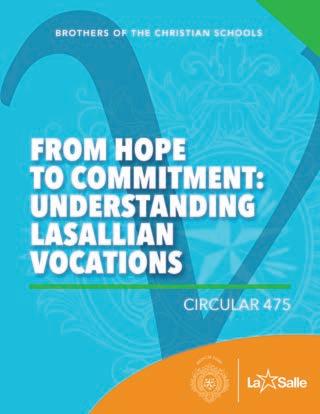
9. Facilitate opportunities to make known the Brothers’ vocation through encounter, ministry with those in most need, prayer and sharing community.
10 Dream about new and next steps to address what is emerging in your life and educational community, perhaps including letting go of what is no longer effective and seeing with “new eyes and new intentions.” (Page 60)
“As Lasallians, let us ask ourselves: What is God’s call for me? How do I come to know God’s plan for my life? What does being Lasallian mean to me?”
(Page 38)
n Saint John Baptist de La Salle held Saint Joseph as a model, encouraging the Brothers to have a special devotion to Joseph as patron of the Institute of the Brothers of the Christian Schools. De La Salle’s writings echo that devotion.
In his meditation for the feast of Saint Joseph, De La Salle reminds us of the qualities and virtues Saint Joseph embodied as he fulfilled his responsibility of caring for Jesus. Citing the Gospel of Matthew, De La Salle writes that Joseph “was just; he was very submissive to God’s orders, and he had a very special solicitude for the education and the protection of Jesus Christ.”
De La Salle urged the Brothers to embody these qualities of Joseph. As this call extends to today’s Brothers and Lasallian Partners, we invited reflections on excerpts from this meditation and what De La Salle’s messages about Saint Joseph mean in ministry today.
Meditation 110.1 – Joseph was just, the main virtue he needed to provide guidance to Jesus Christ
“You also have been charged, very much like Saint Joseph, with a holy work, a work that is very similar to his and requires that your piety and your virtue be more than ordinary. Take Saint Joseph as your model, for he is your patron, and strive to be worthy of your ministry and to excel in virtue by following the example of this great saint.”
Brother Michael French, FSC
Formation and Retreat Facilitator

Midwest District
Saint John Baptist de La Salle enjoins us to imitate Joseph, through virtue and piety. Virtue is behavior showing high moral standards, doing what is right, high character, goodness and excellence. He also extols virtue in Meditation 33.2 on the Good Shepherd. Clearly goodness, truth and excellence of character are important elements of our guidance of young people. Another way of thinking about piety is basically holiness, being dutiful, showing respectfulness toward parents, homeland and other people, a kind of filial piety. These may strike us as old-fashioned until we consider their absence in a world marked by selfishness, disrespect, litigiousness, alternative truth and outright lies. In an atmosphere of contention and division, goodness and respectfulness are a wonderful legacy to bequeath to those entrusted to our care.
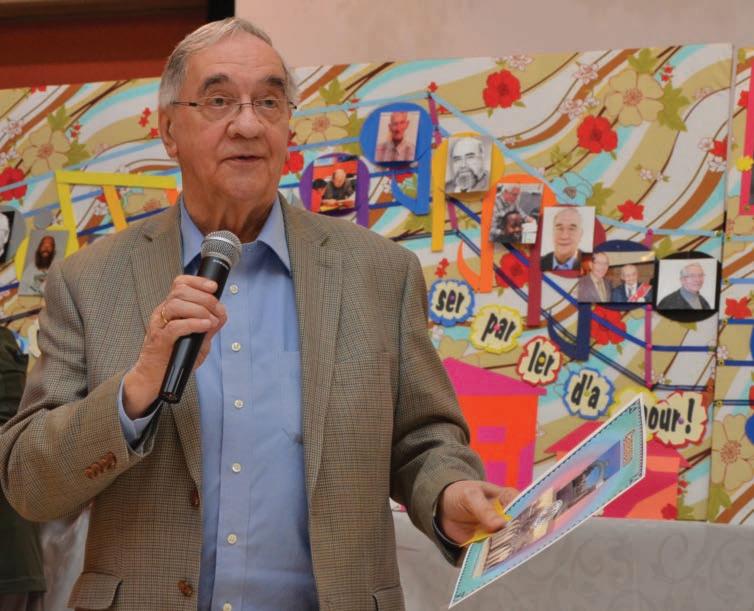
Saint Joseph has been an important fiure since I was a child. Near my home village, there is a mountain dedicated to Saint Joseph where a pilgrimage was held every summer. Suffering from nagging ailments in my legs, I had followed the advice of my maternal grandmother recommending that I participate in this pilgrimage. By the time we got back, the pain was gone. I am therefore willing to share De La Salle’s profound veneration of Saint Joseph. De La Salle proposes Joseph’s paternal relationship with Jesus as a model of the relationship we must have with the young people entrusted to us. Joseph’s model for educators is stronger than that of the guardian angel present elsewhere in his meditations. Joseph’s mission, well defined in Meditation 110, is to protect the God-Child, to educate him religiously and professionally so that he can contribute to society as a disciple of Moses and as the son of a carpenter. The Lasallian educator must do the same for the young people entrusted to him, whom he must consider as sons and daughters of God. He must therefore give them the same care as Joseph’s to Jesus and strive toward the same goal.
Saint Joseph a été un personnage important dès mon enfance. À proximité de mon village natal, il y a un mont dédié à saint Joseph où avait lieu chaque été un pèlerinage. Souffrant de maux lancinants dans mes jambes, j’avais suivi le conseil de ma grand-mère maternelle me recommandant de participer à ce pèlerinage. Au retour, les douleurs avaient disparu. J’étais donc bien disposé pour partager la vénération profonde de De La Salle à l’endroit de saint Joseph. DLS nous propose la relation paternelle de Joseph avec Jésus comme modèle de relation que nous devons avoir à l’endroit des jeunes qui nous sont confiés. Le modèle de Joseph proposé aux éducateurs est plus fort que celui de l’ange-gardien présent ailleurs dans ses méditations. La mission de Joseph, bien définie dans la méditation 110, consiste à protéger l’Enfant-Dieu, à l’éduquer religieusement et professionnellement pour qu’il puisse s’inscrire dans la société comme disciples de Moïse et comme fis de charpentier. L’éducateur lasallien doit faire de même pour ses jeunes qu’il doit considérer comme des fis et des files de Dieu. Il doit donc leur apporter le même soin que celui consacré par Joseph à Jésus et tendre vers le même objectif.
Diahann Larson, AFSC Director of Lasallian Ministry St. Michael’s High School Santa Fe, NM
As I reflect on Saint Joseph and the holy work of parenting a child that did not come from his flesh, I give thanks for the model and inspiration he provided all educators who care for and guide the young students who do not come from their ow n flesh. Continuing this reflection leads me to how De La Salle and the many Christian Brothers embodied that spirit and inspired others to continue the work so that today, I have the blessed opportunity to follow in those same footsteps. A holy work that takes something so ordinary, and makes miracles happen with God’s grace and the work of the Holy Spirit. As Lasallian educators, we are called to strive to teach minds, touch hearts and transform lives. It is an honor to be a part of such a ministry. I only pray that I can learn from Saint Joseph and “foster” young people with as much loving care.
Meditation 110.2 – Joseph’s holy and entire submission to God’s orders
“If you want God to bestow many graces on you, both for you and for the Christian education of the children you have to protect and to guide, you must imitate this saint in his love for and in his fidelity to obedience, which of all the virtues is the one most appropriate for you in your state and in your work and the one that will bring you the most grace.”
Brother Steven Vasoli, FSC Director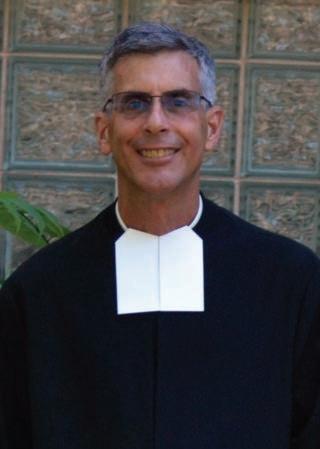 RELAN Novitiate Chicago, IL
RELAN Novitiate Chicago, IL
Of the many ways of explaining obedience, the one that captures my attention is to give ear to, which is a poetic way of saying to hear or to listen to. In addition to the many titles of Saint Joseph, such as Protector of the Holy Family, should be added Patron Saint of Listeners. When we speak about Saint Joseph as being obedient, we are naturally speaking about the Saint Joseph who listened to what God was speaking in his heart and acted accordingly. It seems to me that many sectors of our contemporary societies, including many of our religious
organizations, are having dif ficulty with the ability of listen. One only has to have contact with the daily news to know that our world is not hearing what God has to say to us, nor each other. One of the ways we can all brother and sister is to give ear, to listen to what others are saying: with those with whom we live, with those we serve and minister in our educational centers and with those we encounter in our daily lives.
David Martinez Father and TeacherLa Salle Academy
Providence, RI
I’ve been blessed by God to be a father and a teacher. Like Saint Joseph, I’ve tried my best to be obedient to God and his commandments. The best example of personal obedience I can draw on for the ninth graders I teach in religion class is the marriage vows I exchanged with my wife 35 years ago. “I promise to be true to you in good times and bad, in sickness and health. I will love you and honor you, all the days of my life.” My obedience to those vows and my wife have resulted in the blessing of family: five children and two grandchildren. In a similar way, I promise my students that I will be the best teacher, role model and father fiure I can be because their parents have entrusted them to my care. May Saint Joseph guide me in my personal life and in my religion classroom!
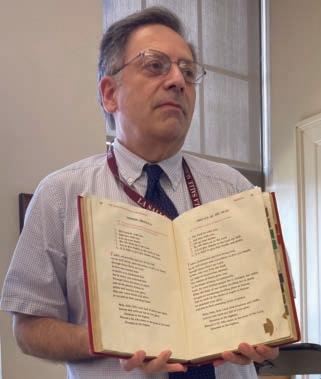
“You must have a similarly great attention and affection for preserving or procuring the innocence of the children entrusted to your guidance and for keeping them away from whatever might interfere with their education or prevent them from acquiring piety, just as Saint Joseph had for all that could contribute to the welfare of the Child Jesus. For you have been made responsible for these children, just as Saint Joseph was made responsible by God for the Savior of the world.”
Sophia Cartagena Behavioral Assistants SupervisorTides Family Services

West Warwick, RI
I feel like the current work I am doing has been a calling, my vocation. While I no longer have my own clients, I supervise staff who have caseloads of children and families entrusted to their care. I see Saint Joseph in those I supervise when they inform me of updates and how they have assisted clients/families in finding housing, providing food or just overall support during a crisis. The behavioral assistants I supervise continue to go above and beyond, and I feel blessed to be a part of their journey in helping clients and their families. They take their
responsibility to help these children very seriously, and it sometimes feels like clients become an extension of our own families and vice versa. My role as supervisor, to me, is similar to Saint Joseph in the support I give to those I supervise and ensuring they have the skills and support to serve clients/families.
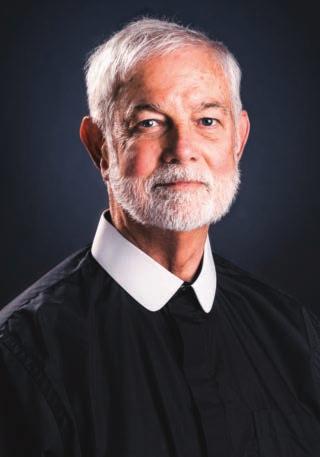 Brother
Brother
When reflecting on the feast day of Saint Joseph, Saint John Baptist de La Salle asks that with great attention and affection we be present to those entrusted to our care. He focuses his reflection around the word “piety.” I learned early on that piety means holiness translated to perfection. I am more comfortable understanding piety, or holiness, to be more about wholeness than perfection. I bring wholeness to my ministry. I have always been drawn toward the early seal, images and symbols of Joseph walking with Jesus. I believe Joseph helped create a sense of home and safety for Jesus to explore who he was and to feel safe in the process of who he was becoming. Saint Luke wrote, “the child grew and became strong, filled with wisdom” to describe the environment Joseph created for Jesus. We all want to feel at home and that we are loved. Those entrusted to my care deserve to feel safe and loved as they step into themselves as the “pious” or holy individuals they were created to be.
To read the full meditation and learn more about the Year of Saint Joseph, visit www.Lasallian.info/Year-of-Saint-Joseph. n
“ For you have been made responsible for these children, just as Saint Joseph was made responsible by God for the Savior of the world.”
—Meditation 110.3Ashley Fletcher is the communications specialist for Christian Brothers Conference. All photos were provided by the writer or the writer’s ministry. Dennis Galvin, FSC Spiritual Director De La Salle Minneapolis Community Minneapolis, MN
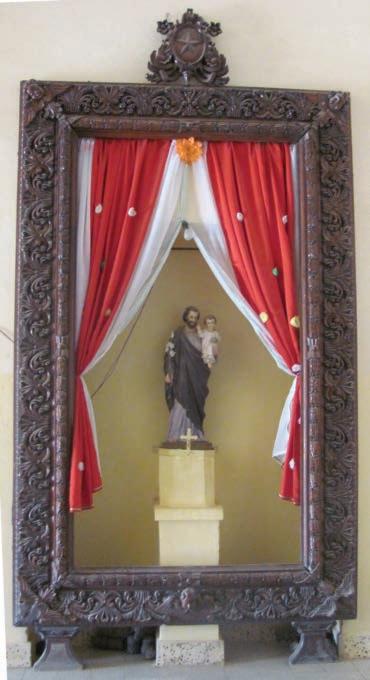
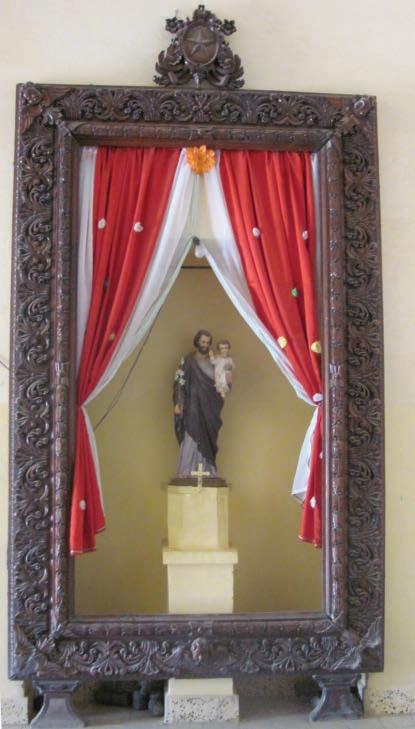
n As we celebrate the Lasallian Year of Saint Joseph, we consider the special meaning this year holds for institutions named after Saint Joseph. Internationally, three of those institutions are in the Lwanga District of Africa. Sharing the name Saint Joseph School, they are located in Addis Ababa, Ethiopia; Nazareth, Ethiopia; and Keren, Eritrea. The Lasallian Region of North America (RELAN) and the Lwanga District share a special connection through the twinning program, which partners middle and secondary schools in RELAN with ministries in Lwanga. While the schools in Addis Ababa and Nazareth are currently part of the twinning program, Saint Joseph School in Keren was nationalized by the government in 2019. The twinning program continues to support efforts of the Brothers’ community in Keren, which is committed to serving young people who attend the school through continued tuition support for students most in need, running a Lasallian youth group, and providing sports, music lessons and workshops.
Brother Ghebreyesus Habte, FSC, Lwanga District Visitor, has a long association with Saint Joseph’s School in Keren, dating back to when he was a student there. In honor of the Lasallian Year of Saint Joseph, he shared the following reflection about how he views Saint Joseph as the protector and patron of his former school.
I starte d first grade at Saint Joseph School in Keren in 1967 at age 11. Before then, I was a shepherd of goats in my village of Shinara, which is 10 kilometers from the town of Keren. The specific place where I spent my childhood was called Sukuanuk, about one kilometer from Shinara, beside the mountain of Jentitaku. Sukuanuk means “the place of thieves” because it was a forest where thieves and bandits hid. That is the place where I grew up until the age of 11. I had around 60 goats, and because of war, killing and burning of villages, all villagers escaped to the town of Keren. That is when I found myself at Saint Joseph School.
The origins of Saint Joseph School date back to 1949 when Brothers Adriano Celentano, Clemente Dionisi and José Salces started a mission for the indigenous people in Keren under a small tent and then a small house, still called Villa Adriano. As the school building was being constructed, the Brothers placed photos of Saint Joseph and Mary within the foundation and displayed a statue of Saint Joseph in a hallway (pictured at left). They prayed, telling Saint Joseph and Mary if they wanted this mission to develop and grow, it was their job to build it. With these words of trust, confidence and faith in the intercession of Saint Joseph and Mary, they started to build the school.
Brother
“Saint Joseph for me is a vivid walking saint and a loving, caring father and protector.”
Brother Ghebreyesus
“Saint Joseph for me is a vivid walking saint and a loving, caring father and protector.”
Ghebreyesus
As a student, Saint Joseph was my school, my home, my life, my everything. I remember the Brothers had to chase us out of the compound to go home after 6:00 p.m., and it was tough for many of us. We never wanted to leave the school premises.
When I became a novice in 1977, I returned to Saint Joseph to teach third grade English, morals/ catechism and Arabic. I moved to Asmara in 1978 and was assigned to Saint Joseph again in 1992. After almost 14 years being away in Asmara and Rome for my studies, I remember my first day back at Saint Joseph with more than 800 students in line to sing the national anthem. I spontaneously thought about how all these years Saint Joseph protected the school from all odds, including wars and bombings. In 1977, part of the school was shelled by tanks and destroyed, but the statue of Saint Joseph remained without any damage. During the months of unrest, the Brothers prayed to Saint
Joseph to protect the school, that it would not be set on fire and destroyed. Saint Joseph protected it well. The statue of Saint Joseph has stood in the middle corridor of the school for more than 70 years. Saint Joseph for me is a vivid walking saint and a loving, caring father and protector.
Saint Joseph’s Day on March 19 was traditionally a day of celebration at the school when all students would participate in Mass and activities. Each class received candies, and teachers and students competed against each other in football, volleyball, basketball and other athletics. All students waited eagerly for the feast of Saint Joseph.
Saint Joseph is not only a father fiure and protector of the Brothers, teachers and students, but for the whole population of Keren. Parishes in the area are named after Saint Joseph, and students’ parents would come to Mass at the school chapel on Sundays.
Brother Ghebreyesus Habte, FSC, pictured here at Cathedral High School in Los Angeles, California, visited RELAN in 2014, 2017 and 2019 to strengthen twinning relationships. Courtesy District of San Francisco New Orleans Communications
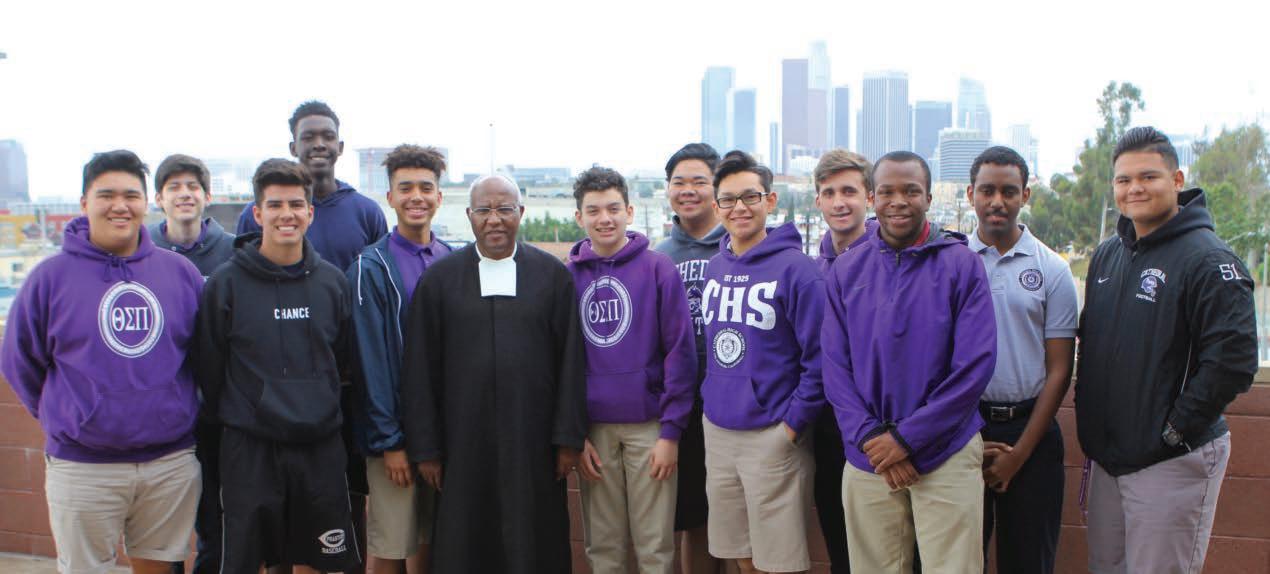
Saint Joseph gave the opportunity of education to thousands of students and protected the school for the more than 70 years. In 2019, the school was nationalized, but I believe and am confident that Saint Joseph and Mary have a message to think about and have a plan for us Brothers and Lasallians in the near future. n
Brother Ghebreyesus Habte, FSC, has served as Visitor of the Lwanga District since 2014 and is an avid supporter of the twinning program. Learn more about twinning at www.Lasallian.info/Twinning.
n In every ministry and community, you find people who quietly serve, offer hope daily, and are true witnesses of faith, service and community. No job is too big or too small. In all they do, they bring their signature love and care. They never ask for anything in return. They are the “silent ones.” Much like Saint Joseph, they serve behind the scenes, silently making a significant impact in all they do.
Compiled by Elizabeth Moors JodiceAs Pope Francis wrote in Patris Corde, “Each of us can discover in Joseph—the man who goes unnoticed, a daily, discreet and hidden presence—an intercessor, a support and a guide in times of trouble. Saint Joseph reminds us that those who appear hidden or in the shadows can play an incomparable role in the history of salvation. A word of recognition and of gratitude is due to them all.”
We put out a call to find and celebrate some of the many “silent ones” who make a difference in their ministries. You will read about some of them here and even more by going to www.Lasallian.info and searching “silent ones.” As you read about these individuals, we invite you to give thanks for them and for the “silent ones” who make a difference each day in your ministry or community.
Katherine Pederson is an excellent example of those individuals quietly, consistently and reliably working behind the scenes at Lasallian institutions around the world. A graduate of the Buttimer Institute of Lasallian Studies, Kathy strives to live the Lasallian charism both at work and at home. She has worked on the Winona campus of Saint Mary’s University of Minnesota for 16 years, the past seven years as the director of Event Services. As part of her job, she interacts with and tends to the facility needs of faculty, staff, coaches, administrators, students and hundreds of university guests. Whether it’s an event for a distinguished speaker, a diocesan retreat group or a wedding, Kathy is there to make sure everything runs smoothly. Her job is endless as each day (night and often weekend) is filled with planning and problem solving for numerous events—often behind the scenes and with little recognition. Kathy’s exudes a can-do attitude, is always willing to volunteer to assist others and is committed to Saint Mary’s mission.

As an alumnus of Archbishop Rummel High School (New Orleans), Heath Barker knew up close what the Brothers of the Christian Schools stand for. He joined the Christian Brothers School faculty two decades ago and immersed himself in the charism, attending both the former Lasallian Leadership Institute and the Buttimer Institute of Lasallian Studies. Heath has been an incredible Lasallian in fl uence at Christian Brothers School. In addition to his fi fth-grade homeroom responsibilities, he doubles as the director of community, ministry and mission, and coordinates spiritual activities for faculty, staff and students, such as prayers and retreats. He has an uncanny ability to create spot-on retreats. He doesn’t just remind students that they are in the presence of God, he is a constant reminder with his demeanor and well thought out responses. He has been a Lasallian light to the school community.

La Salle Educational Center, Homestead, FL
Grace Veloz has served as a board member at the La Salle Educational Center for the past 11 years in a variety of roles, currently as treasurer. Grace’s love for the center began with her father, a decorated alumnus from Cuba, and her grandmother. Grace spent her childhood hearing about Lasallian spirituality and the Brothers. When her dad passed away, Grace made it her mission to continue the tradition by attending alumni gatherings—many times being the only woman present. When Grace was asked to join the board, she was honored but also understood the work needed to support and grow the center. Grace brought many gifts and talents to the center from her background i n fi nances and as a CCD teacher, youth group coordinator and mother of two daughters. Through her dedication, the center has expanded and becom e a fi nancially stable ministry serving more than 300 migrant farming families. Not a day goes by that Grace doesn’t call the center to check on a speci fic student or to work out details for upcoming events.
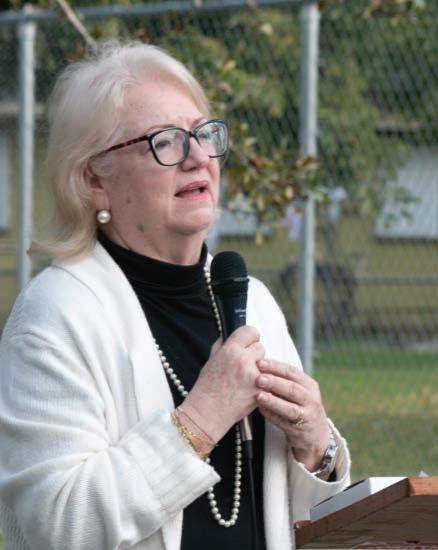
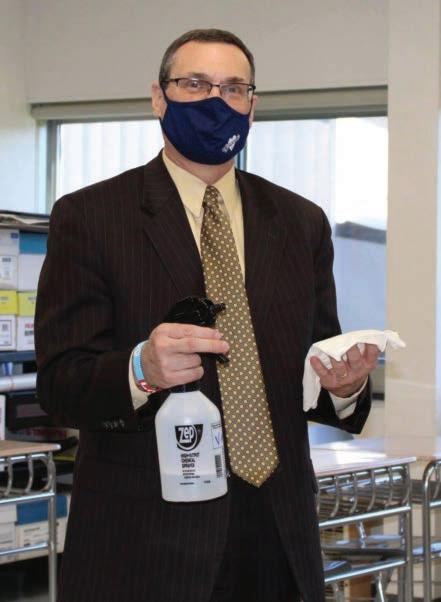
Novitiate, Retreat Centers, Mont Bénilde High School, Résidence De La Salle, Québec
Brother Gérard Nolet, FSC, was born in a poor, rural village in the Centre du Québec region, the 17th child in a family of 19 children. He has spent his life being at the service of others, namely, youth. He has worked in juniorates, novitiates, scholasticates, retreat centers, Brothers’ formation houses, Mont-Bénilde High School, summer residences and now Résidence De La Salle, the Brothers’ full-care community. At Mont-Bénilde, he devoted himself to the boarding school, to the games room (the young people affectionately called him “Brother Games”), maintenance of the pool and supporting the sports teams. Year after year, he collected empty cans to raise money, which he used to buy jerseys for the teams. Even when the school closed, he kept following former students in their tournaments. At Résidence De La Salle, he has served as a tailor, launderer, nurse assistant, treasurer, caretaker, maintenance manager and community director. He welcomes everyone with a smile and always has gentle words of encouragement. His charity and sincere love for the Founder is a strong inspiration for all educators who have had the chance to know him.
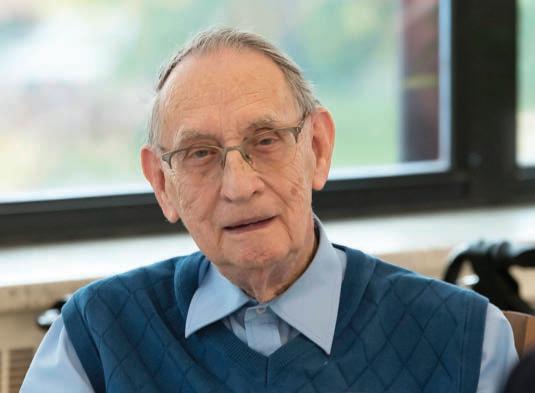
Christian Brothers Academy, Syracuse, NY
David Roache stands out as an educator whose efforts and attitudes impact virtually the entire school community. His duties as a teacher, Lasallian animator, mission and ministry team leader, faculty and new teacher formation coordinator and lecturer, long-term department chair, vice principal of academic affairs and mentor to all reveal the extent of his “public” involvement. But it is the more subtle, behindthe-scenes contributions that really make Dave worthy of gratitude. There are few events that take place without Dave’s helping hands and input. If there are chairs to be set up, books to be carried, events to chaperone, planning assistance needed, Dave is there, with his signature energy and humor, lightening everyone else’s load. No task, no committee work, no sacri fice is not worth doing in Dave’s eyes if it will help students. And if there is an occasion to celebrate or congratulations to express, Dave supplies homemade food and dessert o r flowers whenever called for. Dave shares himself like a Lasallian Saint Joseph, a true witness of faith, service and community.
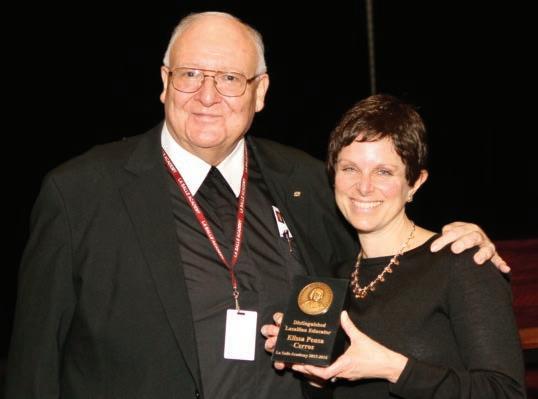
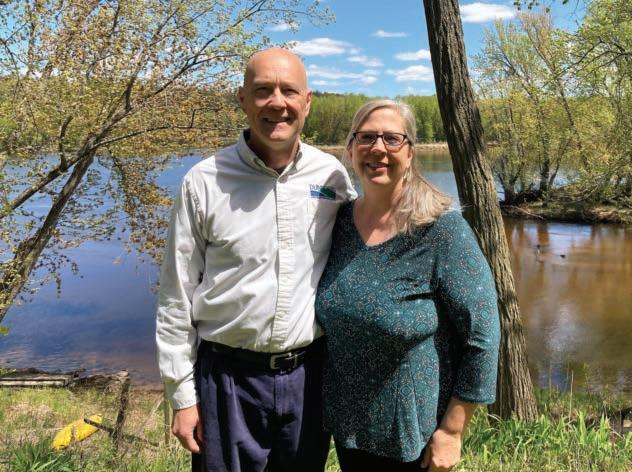
Jerome and Mary Meeds have raised their children from childhood—even infancy—while they have been faithful custodians and ministers of the Gospel at the Dunrovin Retreat Center. They have lived on the property, improved the property, served the poor and embraced the Lasallian charism and mission wholeheartedly. These are the quiet ministers of Jesus Christ who have sought no reward, never asked for anything, and created a safe space for people to encounter the sacred.
When Elissa Pensa-Cerros speaks about the Lasallian mission you can hear the zeal in her voice. She was a founding member of Arts Alive at La Salle Academy (LSA), which makes performing arts available to inner city youth. She is also engaged in the school’s mission trips and community service activities, as well as offering faculty formation with a passion for the role of women in the Lasallian world. Students— especially those wh o fi nd themselves on the margins—know that she is always a “safe place.” Her commitment to the mission goes beyond LSA as she has been quietly in fl uencing the vitality of the global mission for decades. When the Young Lasallian movement was in its infancy, she helped to invite young Lasallian professionals to learn more about it. She served on the International Council for Young Lasallians and was instrumental in the development of the VEGA formation program. Elissa also serves as co-coordinator of the Rhode Island Lasallian Association Group (RILAG). She does all this without fanfare as she sees her vocational call to be that of a “lifelong Lasallian.”
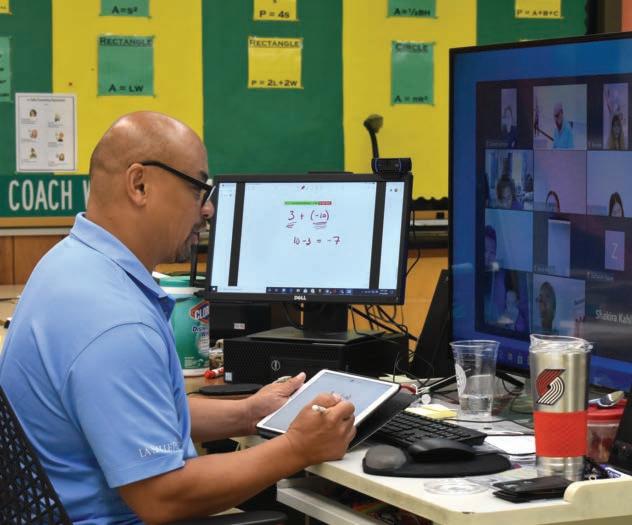 La Salle Catholic College Preparatory, Milwaukie, OR
La Salle Catholic College Preparatory, Milwaukie, OR
Linus Oey, a math teacher at La Salle Catholic College
Preparatory and 1987 graduate of the school, is a perfect example of quiet service. During his 28 years at La Salle, he has served in too many capacities to list, but is mainly known for his work as a math teacher and coach. It would be easy to take his service for granted as he requires no outward recognition. He is th e fi rst to volunteer when the call goes out. He shows up for everything, from staff socials to drama performances to basketball games. He always has an open door to his classroom and is consistently working late to help individual students to succeed. He seeks out those on the margins and enlivens in them an attitude of success and capability. He is genuinely interested in continuous improvement and invests 100% in the school’s collaborative professional development. He is a positive, encouraging and stalwart supporter of everything La Salle and the mission. He is a consummate big brother and an inspiration through his kind, gentle, consistent and dedicated service.
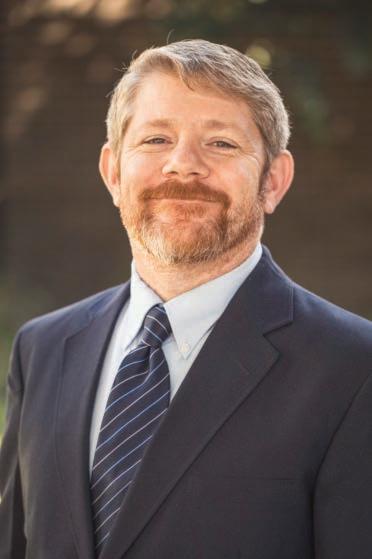
Christian Brothers High School, Memphis, TN
Marcello Donato embodies the virtues of Saint Joseph, quietly completing the tasks necessary to keep Christian Brothers High School running. As director of technology, the pandemic has truly tested Marcello. With only two days to transition, he guided the school from traditional learnin g to fi rst total distance-learning and then a hybrid environment. When it was impossible to a hold back-to-school night for parents in person, Marcello wrote a new program that enabled teachers to have class meetings with parents throughout the evening. Marcello leads the school through his presence, perseverance and faith in God. No technological challenge is too big for him to solve, including helping the Midwest District make its formation website more user friendly. Faculty and staff seek Marcello’s expertise and knowledge. He always makes time to troubleshoot and solve technological problems, produce custom reports, and write programs to make other people’s jobs easier. Always optimistic throughout any challenge, he completes these tasks seamlessly—and usually under a time crunch—with no complaints.
Joseph Preston Director of Campus Ministry

Christian Brothers University, Memphis, TN
Joseph Preston is always available to students, faculty and staff at Christian Brothers University (CBU). He serves on several committees and collaborates well with everyone, especially the two Brothers who work with him in campus ministry. He is a great advocate of the Brother’s vocation. He is Lasallian to the core. Joey genuinely cares about each person he encounters. He lives his faith, which is evident, while always showing respect for those who express their faith differently from him. Joey served for many years in campus ministry at Lewis University, where he absorbed the Lasallian charism. He is currently active with Young Lasallians in the Midwest District. Full of energy for the mission, he is tireless in creative approaches to serving students and staff at CBU.
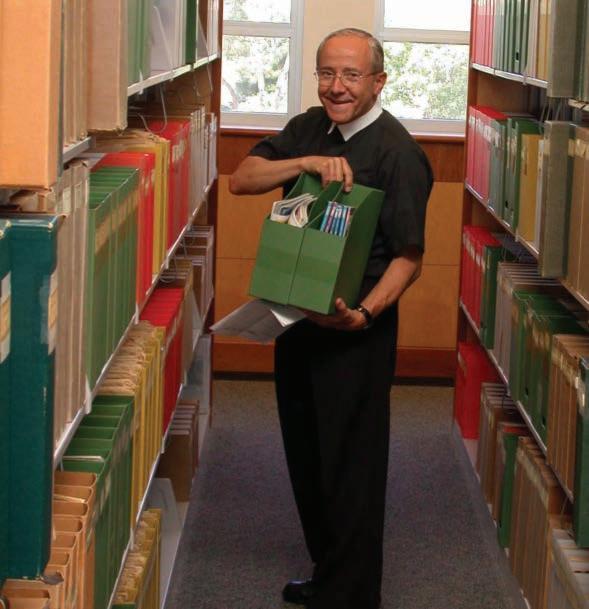
Assistant Librarian
Sacred Heart Cathedral Prep, San Francisco, CA
Brother Joseph Fabiano, FSC, is the epitome of the “silent one.” A great example of the Lasallian spirit, he has been a member of the Sacred Heart Cathedral Brothers Community for years after graduating from Sacred Heart Cathedral as a student. While most people would be enjoying retirement, he continues to be a witness of Christ’s love for all students and staff. Students love him. He can be seen at almost every school function, including visual and performing arts presentations, athletic games and community life activities. In addition to his duties as assistant librarian, Brother Joseph moderates a travel club. He may be soft spoken, but he is a pillar of zeal on campus.

Brother John Grover, FSC, has served at Saint Mary’s University of Minnesota all of his life as a Brother. Born in Fargo, North Dakota, he travels there to see family every couple months, but otherwise remains at Saint Mary’s in service. For more than 30 years, he worked in IT at the university and now is focused on environmental awareness projects. He offers canoeing, cross-country skiing, camping and other activities that introduce students to the natural environment. Brother John is also an avid gardener and grows a variety of produce, including strawberries and honey berries. Brother John is shy, maintains a low pro file and works without any acclaim or notice. He has given his life to his students and the earth.
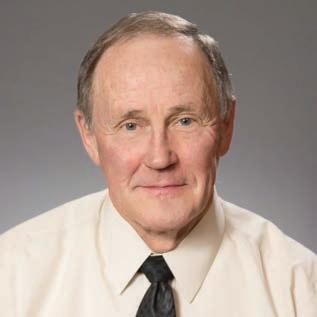
Mike Sommers is Joseph on the Saint Mary’s College High School campus, acting as a loving father to everyone in the school community. A kind, caring, compassionate, cheerful and patient educator, Mike teaches by the example of his gentleness, generosity and Catholic faith. He is a graduate of the Buttimer Institute of Lasallian Studies and has received the school’s Lasallian of the Year award. Mike teaches how to serve Christ an d fi nd joy in service. Outside of school, he volunteers with the Alameda County Food Bank, a variety of marathons, the Prisoners Literature Project, fundraisers for multiple charities and so much more. Battling cancer multiple times in his life, you might think he would give in to despair, but instead he is a shining, con fident example of faith to the school community and beyond. He is a steadfast and committed presence on campus, supporting students in their spiritual growth and caring for them. Mike treats each person with a gentle dignity. He does not seek praise, advancement or self-promotion but is instead a humble and kind servant-leader.
Mary Wilby, Ph.D. Associate Professor of Nursing, Nurse Practitioner Track Coordinator La Salle UniversityHumility about her expertise and her commitment to transforming her students into competent nurses are examples the silent service Mary Wilby, Ph.D., provides to the nursing department at La Salle University. The most recent example of her quiet yet critical impact was through her work on the La Salle University Pandemic Preparedness Task Force. Mary took a major role in developing the university’s contact tracing program, which became a practicum site for her nurse practitioner students. She provided guidance during the vetting process for COVID-19 testing and served as one of three administrators for the day-to-day operations of the testing site. She also serves on the executive board for the faculty senate and provides nursing care to students in the Student Health Center. Mary’s commitment to the mission extends beyond campus. She has participated in formation opportunities at the university, District, Regional and international levels and was a delegate to the 2017 Women’s Symposium in New Zealand. Mary does extensive work with District of Eastern North America initiatives in Haiti and serves on the board of Lasallian Women of Hope. n

n November 21, 2021, marks the 330th anniversary of the Heroic Vow, a private commitment made by John Baptist de La Salle, Nicolas Vuyart and Gabriel Drolin to establish the “Society,” even if only the three of them remained and they had to beg for alms and live on bread alone.
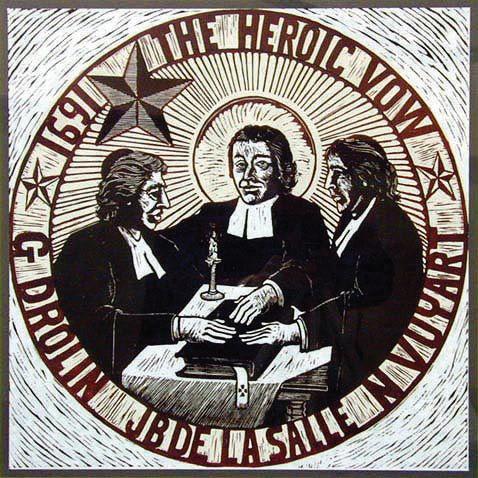
As we celebrate the Lasallian Year of Saint Joseph, an introductory document released by the Superior General and General Councilors called “With a Father’s Heart, Lasallian Year of Saint Joseph, Patron of the Institute,” links the Heroic Vow anniversary and Saint Joseph. It cites a suggestion made by Lasallian scholar Brother Yves Poutet, FSC, (1920-2009) that the Heroic Vow could be more accurately be called the Founding Vow, an echo of Jean-Jacques Olier’s founding vow for the Seminary of Saint-Sulpice in 1641. The document suggests we think of Saint Joseph as the spiritual foundation of the Institute of the Brothers of the Christian Schools, as we look to him for a foundation of righteous behavior, obedience to God, care and love.
As we mark the Heroic Vow anniversary, Brother Gerard Rummery, FSC, noted Lasallian scholar from the District of Australia, New Zealand, Pakistan and Papua New Guinea, explores the events that led up to the Heroic Vow on November 21, 1691, and the idea of the Founding Vow.
In 1982, Brother MauriceAuguste, a noted Lasallian researcher, pursuing information from Père Faillon’s Life of JeanJacques Olier, the founder of Saint-Sulpice, uncovered details that had important implications for our understanding of De La Salle’s actions on November 21, 1691. Faillon had written about what Jean-Jacques Olier and his two companions had done in their quest to open a seminary in the spirit of the decrees of the Council of Trent:
“In 1641, in the village of Vaugirard, Jean-Jacques Olier and two other priests began community life. Their idea was to work towards the establishment of a seminary in spite of the collapse of a previous attempt... To judge according to the rules of human prudence, this foundation seemed completely unreasonable. It was quite rash to go and attempt such a dif ficult work in a dilapidated village, without any temporal support. The three resolved to join together in God’s service and form a Society. As the aim they set themselves was to procure the glory of the Most Holy Trinity by means of priests, they decided to take as the model
of their Society that of the three divine persons, taking divine love as their sole bond without any vow, as Father de Condren had himself recommended to them.
“Accordingly, on November 21st [the day for the clergy to dedicate themselves to their work for the next year] the three went on a pilgrimage to Montmartre [which was then outside Paris] and consecrated themselves to the Most Blessed Trinity with the promise to stay together and work for the instruction and sanctification of the clergy. They did so in these terms in a statutory declaration before a notary:
“‘Three priests, finding themselves called in unity of mind to the service of God and the Holy Church, to train for him ministers to serve his greatness worthily, believe that in honor of the divine society of the three Persons they should unite by a holy promise never to leave one another nor to give up the plan that it has pleased God to show them.’”
Let us remind ourselves that De La Salle had spent two years in the seminary of Saint-Sulpice. While he and his Brothers were living in Vaugirard in 1691, they were, as biographer JeanBaptiste Blain points out, frequently visited by Père Bouin who was spiritual director of the young students at Saint-
Sulpice. Bouin had been De La Salle’s spiritual director since he first went to Saint-Sulpice, and they had now restored their relationship.
By September 1691, eight of the 16 Brothers in Reims had left the Institute, no new novices appeared, and the situation appeared hopeless. Did Bouin perhaps, like any good spiritual director, offer for De La Salle’s reflection something that SaintSulpice would have been celebrating—the story of what Olier and his two companions had done in Vaugirard some 50 years previously?
Since the early 1980s, Brother historians have accepted that Olier’s example of 1641 inspired the writing of the Heroic Vow

of 1691. It is significant that Olier and his companions acted for “the glory of the Most Holy Trinity” by a statutory declaration, binding themselves in law to stay together or to be punished according to the law if they failed to do as they had stated. De La Salle and his companions also bound themselves to the Most Holy Trinity to remain together for their foundation of their society, prepared to stay together even if survival meant that they would have had to beg for food. The very existence of SaintSulpice gave witness to the importance of the risk Olier and his companions took by binding themselves in law and achieving the foundation they desired. Three years after the Heroic Vow, on June 6, 1694, De La Salle and his two companions were joined by 10 others to make the first
Most Holy Trinity, Father, Son and Holy Spirit, prostrate with the most profound respect before your in fi nite and adorable majesty, we consecrate ourselves entirely to you to procure with all our efforts the establishment of the Society of the Christian Schools in the manner which will seem to us most agreeable to you and most advantageous to the said Society.
And for this purpose, I, John Baptist de La Salle, priest; I, Nicolas Vuyart, and I, Gabriel Drolin, from now on and forever, until the last surviving one of us or unto the complete establishment of the said Society, make the vow of association and union to bring about and maintain the said establishment, without being able to withdraw from this obligation even if only we three remained in the said Society and if we were obliged to beg for alms and to live on bread alone.
In view of which, we promise to do, all together and by common accord, everything that we shall think in conscience and regardless of any human consideration to be for the greater good of the said Society.
Done on this twenty-fi rst day of November, feast of the Presentation of Our Lady, 1691. In testimony of which we have signed.
perpetual vows in the Institute of obedience, stability in the Society, and association to conduct the gratuitous schools. This gave witness to the “success” of their risk, especially when we consider the following details:
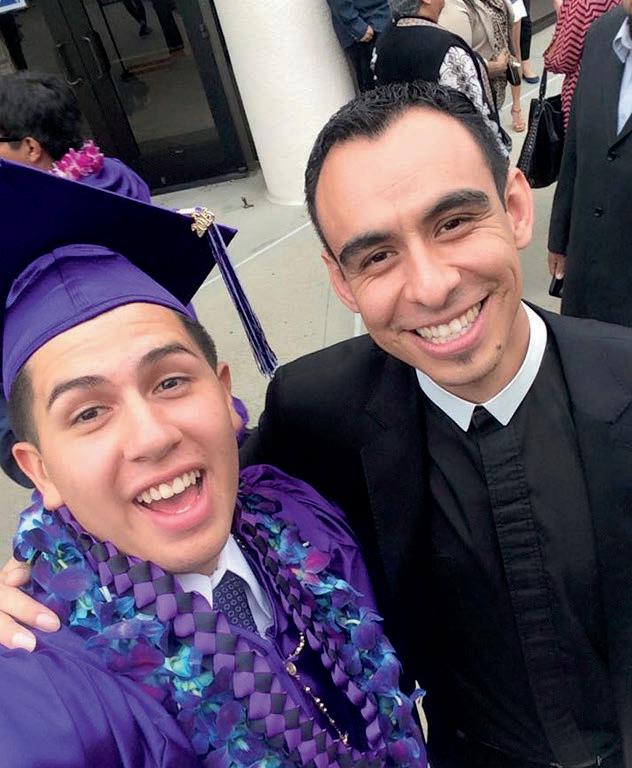
• The Heroic Vow was to continue “until the last surviving of one of us” or “unto the complete establishment of the said Society.”
• Each Brother in 1694, in his own hand, wrote the same form of consecration, naming
myself and to remain in Society with … to keep together and by association gratuitous schools wherever they may be ”
The 1694 formula stated, “Wherefore, I promise and vow obedience to the body of the Society as well as to the superiors, which vows of association as well as of stability in the said Society and of obedience I promise to keep inviolably all my life.”
Yves Poutet is undoubtedly
Institute. That there had even been a Heroic Vow was not generally known until after Gabriel Drolin’s return from Rome in 1727, eight years after De La Salle’s death. De La Salle and his two companions placed their trust in God’s providence and continued to work to build their Society. What took place on June 6, 1694, is the realization of what they had vowed in faith. n
Brother Gerard Rummery, FSC, from the District of Australia, New Zealand,10 International Assembly of the Lasallian Educational Mission (AIMEL), Virtual Gatherings Begin
13 LVs Run, Virtual
13 International Young Brothers Assembly (IYBA), Virtual
17–18 Lasallian Education Council (LEC) Meeting, Baltimore, MD
18–20 Huether Lasallian Conference, Baltimore, MD
21 Lasallian Volunteers Advisory Board (LVAB) Meeting, Baltimore, MD
21 Regional Communications Team (RCT) Meeting, Baltimore, MD
2–4 Regional Formation Institute (RFI), Chicago, IL
10–12 Regional Council of Young Lasallians (RCYL) Meeting, Chicago, IL
5–6 Regional Conference of Christian Brothers (RCCB) Meeting, Napa, CA
8 IYBA, Virtual
15–18 Lasallian Volunteers Midyear Retreat, Reisterstown, MD
18–22 Brothers in Initial Formation Gathering, Ocean City, NJ
27–
Mar. 2 Lasallian Association of Secondary School Chief Administrators (LASSCA) Conference, Orlando, FL
12 IYBA, Virtual
13–16 Regional Vocation Formation Committee (RVFC) Meeting, Napa, CA
APRIL 2022
1 AIMEL, Virtual Gatherings Conclude
20 Regional Finance Committee (RFC) Meeting, Virtual
27–30 Regional Formation Programs Advisory Committee (RFPAC) Meeting, Westmont, IL
MAY 2022
1–22 46th General Chapter, Rome, Italy
27–30 Lasallian Volunteers Debriefing Retreat, Plano, IL
*Dates and locations are subject to change due to COVID-19 concerns.

Christian Brothers Conference 415 Michigan Avenue NE, Suite 300 Washington, DC 20017
